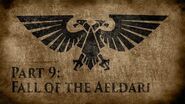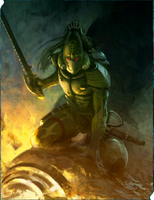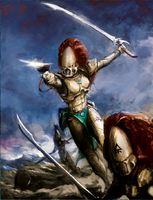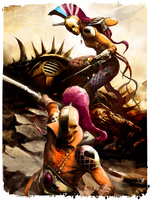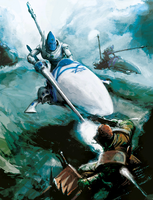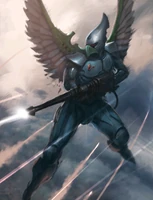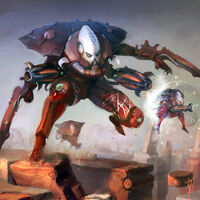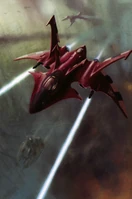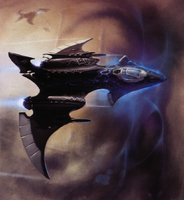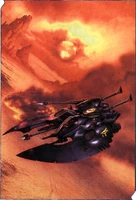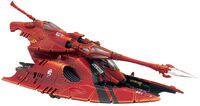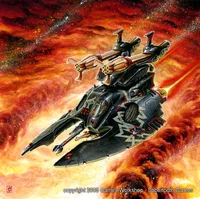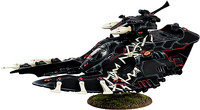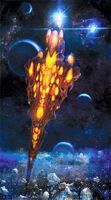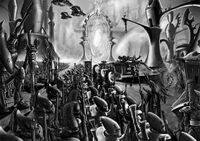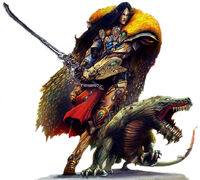"Trust not in their appearance for the Eldar are as utterly alien to good, honest men as the vile Tyranids and savage Orks. They are capricious and fickle, attacking without cause or warning. There is no understanding them for there is nothing to understand -- they are a random force in the universe."
- —Imperial Commander Abriel Hum
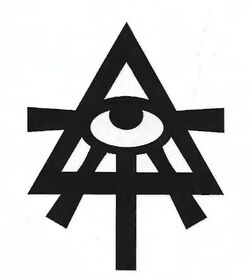
Rune representing the Asuryani or Craftworld Aeldari in the Aeldari Lexicon.
The Asuryani (Aeldarix dolosus) ("Children of Asuryan" in the Aeldari Lexicon, pronounced "ah-SUR-ee-AH-nee"), also called Craftworld Aeldari as they were named before the fall of their lost realm, or the Eldar as they were long known to outsiders, or even the "Eldar of the Stars," are an ancient, humanoid alien species whose vast empire once extended the width and breadth of the known galaxy. The Asuryani are a kindred of the Aeldari species who now live on vast, city-like starships called craftworlds.
The Aeldari Empire was without equal, and they counted themselves masters of the stars. But over ten Terran millennia ago, the Aeldari's overweening pride and their fall into hedonistic practices led to a cataclysm that all but eradicated their kind and led to the birth of the Chaos God Slaanesh.
Despite their boundless power, the heart of their civilisation was torn out by this catastrophe of their own making, forcing many of the surviving Aeldari, now calling themselves "Eldar" to outsiders and "Asuryani" among themselves, to flee upon gigantic, continent-size starships once used for commerce and trade that they named craftworlds. Now the Asuryani cling to survival by a thread, fighting the horrors of the galaxy with ritualised mental discipline and consummate martial skill.
The Asuryani rely on mystical technologies like psychocrystalline Spirit Stones and the psychoactive wraithbone Infinity Circuits that comprise the skeletons of their craftworlds to store their souls after death and prevent their consumption by Slaanesh.
It is the use of these technologies and their pursuit of a rigid system of behavioural modification to keep their darker impulses in check that shape the Asuryani lifestyle and define their culture as distinct from that of the other Aeldari sub-cultures.
The Aeldari species has a long and complex spacefaring history, so long in fact that little is known for certain about the course of their physical evolution and early planet-bound existence. The original Aeldari homeworld was destroyed during the catastrophic collapse of the Aeldari civilisation known as the Fall of the Aeldari.
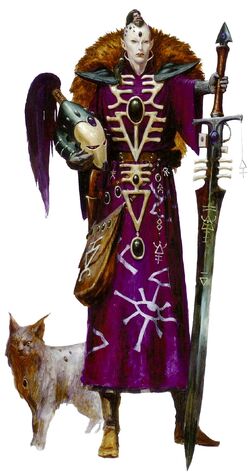
The Asuryani Warlock Arquellia of the Ulthwé Craftworld, wielding a Witchblade while being accompanied by her pet Grynix.
The remnants of Aeldari culture that survived the cataclysm among the Asuryani preserved much of their species' history in the form of traditional stories, songs and dance. Written records, monuments and visual records were almost completely destroyed except for a few instances where they were taken aboard voidcraft fleeing from the doomed worlds.
As a humanoid race, Aeldari are physically very similar to Humans, although not entirely identical by any means. They possess longer and cleaner limbs, and fine ascetic features with penetrating and slightly slanted, almond-shaped eyes.
Their ears are also slightly pointed, but otherwise they could pass as Human at first glance. The most obvious difference between Humans and Aeldari can only be seen when they move, for the movements of an Aeldari radiate a subtle grace which is impossible for a Human to emulate.
This can be seen in even their slightest gestures or the dexterity with which they manipulate small objects.
The Aeldari mind, while similar in general to the Human psyche, is far more inclined towards emotional extremes. Because of this, Aeldari are more intelligent but also far more intense than Humans.
Although an Aeldari and a Human can both feel grief or joy, the Aeldari's experience is likely to be far more extreme.
This natural inclination towards emotional extremes is both a blessing and a curse to the Aeldari. On the positive side, it gives them an unparalleled appreciation of life and an unrivalled ability to express themselves through music and other creative endeavours.
A melody or gesture made with grace and skill can elicit an intensity of pleasure which is unimaginable to a Human.
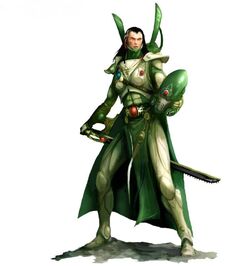
An Autarch of the Asuryani Craftworld Biel-Tan.
But this potential for joy is paralleled by an equal capacity to feel despair, ambition and even hatred. Confronted by grief or other personal setbacks, an Aeldari suffers mental torments which far exceed the boundaries of Human anguish.
The extreme nature of their temperament makes it very important that the Aeldari maintain a measure of self-control at all times, for it is dangerously easy for them to become entranced by and ultimately dependent upon the experiences that their culture offers them.
They must learn to control the darker side of their natures, which is no less an essential portion of the Aeldari psyche -- and the source of the catastrophe that nearly caused their extinction.
For this reason, the Asuryani are defined as a culture by their pursuit of the Asuryani Path. This philosophy teaches them how to balance their potent minds and pursue constructive goals rather than falling to the amoral pursuit of pleasure and selfishness that ultimately destroyed the ancient Aeldari and still defines their dark kin, the Drukhari.
The Aeldari are a naturally psychic species, and all Asuryani possess the potential to become powerful psykers if they choose to pursue this path. The Asuryani can use these innate abilities to shape matter, which lies at the foundation of their extraordinary command of technology.
Though highly advanced and feared across the galaxy, the Craftworld Aeldari are still a dying people in the late 41st Millennium -- a shadow of their former glory -- and their species teeters on the brink of final annihilation.
Nomenclature
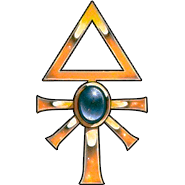
Rune for the Aeldari species in the Aeldari Lexicon.
The entire species of beings who once ruled the galaxy-spanning Aeldari Empire for millions of Terran years are called the "Aeldari." In the wake of the Fall of the Aeldari, the survivors of the great cataclysm adopted new names for their varying sub-cultures or kindreds.
The Aeldari who fled their ancient empire in the craftworlds eventually called themselves the "Asuryani" since their culture was redefined by their decision to pursue the Asuryani Path that they believed had been laid out for them by the chief Aeldari god, the Phoenix King Asuryan.
Linguistically reflecting their diminished status, the Asuryani made themselves known to outsiders as "Eldar," a name which came to be applied to the entire species by Imperial scholars for many millennia.
Likewise, the Drukhari were the malevolent faction of the ancient Aeldari who had chosen to remain within the Webway after the Fall and continued to pursue the decadent and hedonistic ways that nearly led to their extinction.
However, they were often referred to by outsiders as "Dark Eldar," a term which they rarely used for themselves and which was first coined by Asdrubael Vect, the supreme overlord of Commorragh, from the Aeldari phrase "Eladrith Ynneas" in the 32nd Millennium.
Those wilderness-loving Aeldari who settled on Maiden Worlds many solar decades before the Fall in the hope of avoiding the worsening corruption of the Aeldari culture are known as "Exodites."
The servants of the Aeldari Laughing God Cegorach, who were protected by his influence within the Webway from being slain during the Fall, are called the "Harlequins" in the most common translation of the Aeldari term for the faction into Low Gothic.
In recent years, since the formation of the Ynnari faction which contains members of the Aeldari species from all of the other kindreds, it has become common for many of the Asuryani to once more refer to themselves using the ancient term "Aeldari."
This reflects the Ynnari belief that with the awakening of Ynnead, the Aeldari god of the dead, their species is once more on the path to resurrecting its lost glory.
In the Era Indomitus, the term Aeldari has come to be preferred to Eldar, though the original name for the Asuryani best known by the Imperium of Man is still often used interchangeably.
However, it is now more correct to refer to the Aeldari of the craftworlds as simply "Aeldari," "Craftworld Aeldari," or when comparing them to the other Aeldari kindreds, the "Asuryani."
The Drukhari are still often referred to in the Imperium as "Dark Eldar."
Anatomy and Physiology
"Mon-keigh, we do not fight for you, or for your corpse-Emperor. We are allied here today because destiny has seen fit to bind our fates together. We do not relish that our futures are intertwined, but if you would live to see another day, then you will do as I say. Order your soldiers to cease firing their primitive artillery upon the ridge line, for it is there the Asuryani warhost will arrive. My kin will drive the tainted ones back towards your lines, where you would do well to be prepared. And please, above all else, stand down wind from me. "
- —Beac-dair, Ranger of Alaitoc, liaison to Imperial forces in combat with the forces of Chaos
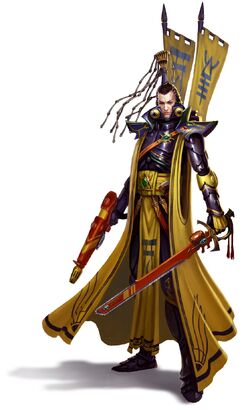
An Asuryani Autarch of Craftworld Iyanden.
Superficially, the Aeldari appear very similar to Humans in their anatomy, although the comparison can only be made on a superficial basis, for in their minds and souls the Aeldari are truly alien. The Aeldari stand taller than a Human male, with longer, cleaner limbs and handsome, striking features to Human eyes.
Their skin is pale and unblemished as polished marble, yet with a surprisingly supple strength hiding beneath it. Their keen ears are pointed and their slanted eyes possess a penetrating quality more akin to that of a hunting cat than a man.
The most fundamental difference can be seen when the Aeldari move, for they each radiate an inhuman elegance and poise. This is especially evident in the sinuous grace with which they fight and the dexterity with which they field their weaponry. Every gesture is laden with subtle intent, and their reflexes are dazzlingly fast. A casual, languid gesture can end in a pinpoint thrust should the necessity arise.
On closer inspection, every aspect of the Aeldari physiology betrays their alien nature. Their hearts beat at twice the speed of a Human's, and their minds race through possibilities and process emotions so fast that even the so-called geniuses of Human history appear dull by comparison. Even their lives are greater in span -- the Craftworld Aeldari enjoy lives of rich sensation and wonder that can stretch over a thousand Terran years, unsullied by illness, frailty or disease, unless they die by violence or accident.
All Aeldari can manipulate mental energies to a degree. Each is psychic to one extent or another; it is said the ancient Aeldari could read thoughts at a glance, whilst those who trained their minds for war could crush a foe's weapon with a simple narrowing of their eyes.
Even the complex technology of their race is based upon psychic engineering, the manipulation of and even creation of matter using mental energies alone. But such raw power has its price.
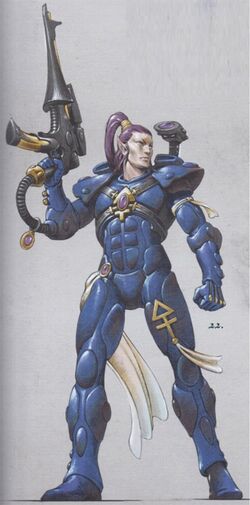
An Asuryani Guardian
The same neurological mechanisms that grant the Aeldari mind such power also inclines it far more towards extremes than that of a Human. To an Aeldari, all of life's experiences are available on a far grander scale: the individual rewards of study, the exhilaration of battle, and every imaginable pleasure or sensation in-between.
An Aeldari will at some point climb the most noble peaks of accomplishment, just as they will plunge into the darkest abyss of doubt. Their capacity to experience emotion enables them to attain transcendent bliss or, in contrast, experience soul-wracking sorrow.
This spiritual intensity is writ large throughout their culture, manifesting in sublime works of art and music, but also giving rise to a darkness that threatens to engulf them all. No creature, not even an Aeldari, can taste such rich fruits in an uncontrolled way without consequence; for an Aeldari to yield absolutely to the intensity of their desires would destroy them. Such was the fate of their ancient empire, whose depravities brought about the Fall of the Aeldari race itself.
The Aeldari that actively cultivate their psychic potential seem to exhibit a much-extended lifespan even by their standards as well, one proportional to their prowess as a psyker. In this way the leaders and Seers of the Asuryani may live for several thousand standard years.
One matter of note is that the Aeldari have sometimes referred to Humans simply as "mammals" typically with a derogatory label in the Aeldari Lexicon like "the Mon-Keigh," implying that for their part, the Aeldari evolved from something else, something more advanced than the primates that are the ancestors of Mankind.
However, given the Aeldari's legendary arrogance and fickleness, this may also simply be a way for them to put themselves above the other intelligent races of the galaxy, particularly the Humans who are currently the most dominant intelligent species, much to the Aeldari's disdain.
The Aeldari likely see themselves as completely separate from the normal classifications of animal groups. Indeed, they may not even have naturally evolved at all, as they are the genetic creations of the Old Ones, much like the Orks, created to defend the galaxy and the Old Ones' civilisation from the depredations of the Necrons and their C'tan masters during the War in Heaven.
History
"For the ancient Aeldari, life was a cycle of birth, the fulfilment of desire, and a comfortable death, safe in the knowledge the soul would live again. The birth of their nemesis, the Dark God Slaanesh, shattered that cycle forever. Now these once-great starfarers cower in the shadows, too afraid of their own lusts to embrace the full spectrum of sensation. It is a fate they justly deserve. In truth, there can be no escape from the doom they have brought upon themselves – not this side of the grave. Fate is a cruel mistress, and not to be courted lightly."
- — Ahriman, Arch-Sorcerer of the Thousand Sons
The ancient history of the Eldar, or Aeldari as they were known before their Fall, stretches back over the millennia to a time when they dominated the stars completely.
Yet, for all their splendour and might, the Aeldari brought a terrible curse upon themselves that sundered their empire forever, leaving the ravaged fragments of their race teetering on the brink of annihilation.
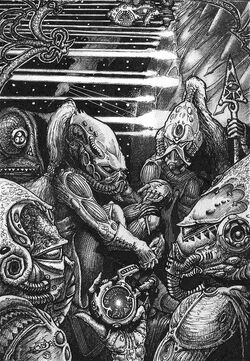
Ancient Aeldari lead their people aboard the Craftworlds to salvation before the Fall of the Aeldari.
All of the Aeldari alive today are essentially a refugee population, the scattered remains of a formerly vast interstellar empire. Even in such straits, however, they are still a deadly and influential force in the galaxy. Once, over ten thousand Terran years past, the Aeldari were perhaps the most powerful starfaring species in existence, dominating a significant portion of the galaxy and secure in their prosperity.
Although there were other intelligent races who possessed advanced technology and potent military power in the galaxy, none were in a position to seriously threaten the state of the Aeldari Empire. When it came, the disaster for the Aeldari people was self-inflicted.
Lost in the vastness of space, the craftworlds float in utter isolation like scattered jewels upon a pall of velvet. Distant from the warmth of sun or planet, their domes gaze into the darkness of empty space. Inner lights glisten like phosphorus through semi-transparent surfaces. Within them live the survivors of a civilisation abandoned aeons ago amidst terrifying destruction.
These are the Craftworld Aeldari or Asuryani, who for so long called themselves the Eldar to outsiders, a race that is all but extinct, the last remnants of a people whose mere dreams once overturned worlds and quenched suns. The starfaring history of the Aeldari is long indeed, and encompasses glories and sorrows alike.
When their empire was at its height, their homeworlds were paradises, their powers godlike and their armies unsurpassed. As the centuries slid past, their status as lords of the galaxy bred an arrogance that led to a cataclysmic end.
A proportion of their species survived that dark time by fleeing from disaster upon the great vessels known as craftworlds. Others settled verdant planets far from the heart of their empire, and still more hid in private, interdimensional realms of their own making. Yet there was no real escape from what was to come.
Children of the Stars
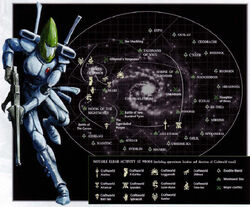
Asuryani craftworlds and other activities in the Milky Way Galaxy, 998.M41.
Over a million Terran years ago, the Aeldari alone ruled the stars of the galaxy as the undisputed masters of their own destiny. Such a position was their right, they thought, and their preeminence was beyond doubt.
In many ways, the Aeldari had good reason for such hubris, for no other species had posed a serious threat to their wealth and stability for time immemorial. They were convinced that they no longer had anything to fear from the galaxy at large, and they may have been right, but the real danger came from within.
The doom of the Aeldari, when it came, took a form far more subtle and dangerous than that of alien invasion. At that point in Aeldari history, nothing was beyond their reach and nothing was forbidden. The ancient race continued their glorious existence unaware or unwilling to acknowledge the dark fate that awaited them.
They plied the stars at will, experiencing the wonders of the galaxy and immersing themselves completely in the endless sensations that it offered them. Such was the technological mastery of the Aeldari that worlds were created specifically for their pleasure, and stars lived or died at their whim.
On hundreds of idyllic planets seeded across the stars, the Aeldari pursued their inclinations as they willed, indulging every dream and investigating every curiosity. They mastered the labyrinth dimension of the Webway, expanded their realms into the furthest corners of reality and learned much about the universe that has since been forgotten.
Even death was no barrier, for when their souls eventually left their mortal bodies they dissolved peacefully back into the Immaterium to be reborn again in new Aeldari bodies, for the Warp did not thirst for Aeldari souls then as it does today.
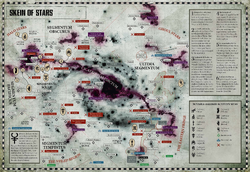
A map of Craftworld Aeldari activity in the wake of the birth of the Great Rift.
There were, of course, many wars. Even when the galaxy was young there were upstart species seeking to gouge out petty empires of their own, and the Aeldari waged wars against the sprawling Necron dynasties that ravaged dozens of star systems and cost trillions of lives.
Most of these conflicts, though, were so short-lived that the ease of their victory left the Aeldari ever more sure of their ascendancy and superiority. Even the greatest of all their wars, known in the mythic cycles of the craftworlds as the War in Heaven, did not humble them. In their hearts the Aeldari reigned supreme, and no other power could end their dominance.
Descent into Decadence
"Find pleasure in every moment, indulge in every whim. Let lesser races feel the burden of their crude lives. We are beyond such concerns or worries. Every power is ours to use, every sensation ours to experience. We are truly masters of the galaxy, and all others exist only to satisfy our curiosities. We have earned our position of power. Let us forever taste the fruits of such achievement. Time itself is ours to command. We are eternal."
- — Translated Eldar glyphs found amidst the ruins of the Shrine of Celestial Grandeur
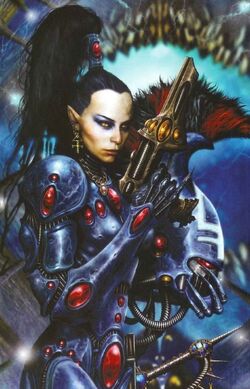
A Dire Avenger Aspect Warrior of the Asuryani.
The catalyst that brought about the Aeldari race's fall came from the very depths of the Aeldari's collective psyche, the innate need to fuel their passions and indulge in every extreme of sensation.
The Aeldari had long outgrown the need for physical labour or manual agriculture due to the highly advanced and automated nature of their technology. Society society provided all the required necessities of life without individual effort, leaving long Terran centuries for the Aeldari to spend sating their every desire.
Fuelled by an inexhaustible curiosity, many gave way to their most hedonistic impulses. Exotic cults sprang up across the Aeldari domains that eclipsed the noble pursuits of old, each dedicated to esoteric knowledge or sensual excess. The core of the Aeldari race began to look inwards, inexorably seeking new ways to explore the full range of emotion and sensation.
With no need to perform substantial work or labour, the Aeldari began to pursue their curiosities and desires with all the dedication that only their species could muster. In the later days of Aeldari civilisation, cults devoted to exotic knowledge, physical pleasures, and ever-more outrageous forms of entertainment sprang up.
It did not take long for many of the Aeldari to pursue a darker path to achieve instant fulfillment as they came to revel in unbridled hedonism and violence. Such behaviour was perilously decadent and, in the end, corrosive to the soul of the race. The pursuit of excess gradually became a blight upon the whole society.
Many of the Aeldari grew uneasy with the actions of their comrades, and the wisest of the Seers warned that this path could lead only to evil and suffering for the entire species. As these pleasure cults gained a tighter hold over their society, the Aeldari became increasingly divided.
Those who saw the foulness that corrupted their people for what it was early on became known as Exodites, fleeing to found colony worlds on the fringes of the Aeldari Empire. As the civilisation slid further into anarchy, others repented of their ways in the days just before disaster struck and left the central worlds of their empire to settle in the outlying regions of the galaxy, where they built great worldships called craftworlds.
Other Aeldari stayed on the homeworlds to try and alter the path their people had taken. Most continued to glut themselves on the pursuits of the depraved.
The heartfelt sorrow of those left who mourned the loss of innocence eventually turned to bitterness and spite. In time, brother fought brother, and sadistic killers stalked the shadows in search of victims for their vile lusts.
No life was spared in the pursuit of pleasures both murderous and perverse. A sickness of vice overtook the Aeldari race, and blood flowed through the streets amidst the bestial roar of the crowd.
Their hidden, interdimensional realms within the Webway became sprawling palaces of avarice and sadism, and entire worlds were bent to the pursuit of the darkest of sensations. As the moral corruption of the Aeldari people tightened its stranglehold, echoes of their ecstasy and agony began to ripple through time and space.
In the parallel dimension of the Immaterium, the reflections of these intense experiences began to coalesce, for the shifting tides of the Empyrean can take form around intense emotion emitted by thinking beings in realspace. Slowly, silently, a nascent god of excess grew strong in the depths of the Warp.
Birth of a Dark God
"To the dark side of the Aeldari mind, all life is to be expended on a whim. Cruelty and generosity are but the impulse of a moment. Beauty and sensuality are virtues that can be expressed in bloodshed just as easily as in song. To an unfettered Aeldari mind there is neither sanity nor madness, but merely a wave of perfect existence fulfilled by its own savage momentum."
- —Ralamine Mung, Ordo Xenos
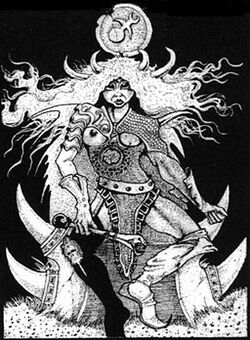
The torture cults eroded the future of the Aeldari as a viable galactic empire. While this debauchery would have been destructive within any society, it was even more damaging for the Aeldari because of their powerful psychic abilities. Within the parallel dimensional realm of the Warp, the psychic emanations of these perverse activities began to gather, strengthened by the souls of departed Aeldari hedonists and pleasure cultists.
As the Aeldari's vices grew, this dark mass of negative psychic energy did as well, producing the terrible Warp Storms that defined Humanity's Age of Strife and made all interstellar travel and communication impossible for the human colonies of this period. What an unimaginably foul and sickening thing it was that the Aeldari unknowingly raised in the Warp; it was a dire shadow of themselves, of what they had become, of nobility and pride brought low by perversity and shamelessness.
Worlds burned as the Aeldari slew and laughed and feasted upon the corpses of the dead. Slowly, the Great Enemy stirred towards wakefulness. Too late, the Aeldari realised that they had created a god in their own image, a god grown immense and potent by suckling upon the dark fodder of the Aeldari spirit.
Eventually, this growing mass of negative psychic energy came into a life of its own and came to consciousness over ten thousand standard years ago at the end of the Age of Strife as the newborn Chaos God Slaanesh, the Devourer of Souls and the doom of the Aeldari. When Slaanesh finally burst into divine consciousness, there was not one Aeldari alive who did not feel its claws in his soul.
With a howl of raw power, Slaanesh roared into supernatural life. A psychic implosion tore at the universe. The psychic scream of Slaanesh's birth ripped the souls from the bodies of all the Aeldari within a thousand light years of it, sparing only those sheltered in the wraithbone hulls of the craftworlds, the Exodite inhabitants of the farthest flung Maiden Worlds, and those members of the pleasure cults who had taken up residence in the protected sub-realms of the Webway like Commorragh.
Countless billions of Aeldari screamed aloud and fell dead. In a heartbeat, the shining Aeldari civilisation that had lasted for aeons had its heart ripped out, leaving a pulsing afterbirth of pure chaos in its place. The spirits of the Aeldari were drawn from within them and consumed as their blasphemous creation took its first infernal breath. Intoxicated with this draught, Slaanesh, named by the Aeldari as "She Who Thirsts," laughed and looked upon a universe ripe for the taking.
Fall of the Aeldari
The epicentre of the psychic apocalypse lay within the gilded heart of the Aeldari realms. All Aeldari within thousands of light years were reduced to lifeless husks, their souls forever claimed by the newborn Dark God. Even those who had foreseen the catastrophe and fled upon the craftworlds were overwhelmed, with only those furthest from the devastation surviving.
The remote Exodite worlds remained largely untouched, but within the space of a single moment, the Aeldari had become a doomed people. Their nemesis was born and would hunt them for the rest of eternity. Though the psychic shockwave focused upon the Aeldari, billions of humans, Orks and creatures from other races were obliterated as well. Warpspace convulsed as a cosmic hurricane raged across the galaxy. The fabric of reality was torn apart and the Warp spilled from the newborn dimensional rift into the material universe, turning hope into despair and paradise into hell.
Psykers of all species howled with pain as their people died in storms of blood and madness. The roiling wound in realspace spread outward until it completely encompassed the Aeldari realms of old. This gaping lesion would come to be known as the "Eye of Terror;" the largest area in the galaxy where the Warp and the material universe overlap until the birth of the Great Rift in 999.M41.
Within its reaches daemons bathe in the raw energy of the Warp, whilst Daemon Princes and the worshippers of Chaos rule over Aeldari planets turned into nightmare worlds of fire and darkness.
For ten thousand long Terran years before the Fall, the Warp had been riven with storm and tempest, making it almost impossible for the vessels of the lesser races to travel between the stars. With the birth of Slaanesh, the Warp was becalmed, its rage temporarily spent.
A new equilibrium was reached as Slaanesh joined the ranks of the Chaos Gods. With the Warp Storms around ancient Terra dispersed, the Emperor of Mankind was able to launch His Great Crusade. A new power took its place in the galaxy as isolated human worlds from across the stars were united under the same banner. In this way, the Fall of the Aeldari heralded the rise of the Imperium, and Mankind inherited the stars.
The Fight for Survival
In the aftermath of what became known as the "Fall of the Aeldari," the Aeldari have faced a long and painful decline. On far-flung planets teeming with natural life, the Exodites have carved themselves a survivalist niche. Savage, primal places where everyday life was hard, these realms helped the Exodites to remain focussed on the ascetic lifestyle they had chosen.
At first, many of their number fought and died against dangerous aliens such as the greenskinned Orks and even the soldiers of the nascent Imperium, but many others survived, reaching equilibrium and living in harmony with their adopted worlds.
In the darkness of space, the remnants of the Aeldari Empire cling onto what was left of their once-mighty culture, preserving the art and architecture of their people within the craftworlds and passing their ancient history from generation to generation via song, dance and the recital of myths and parables. Aboard their continent-sized vessels, these fragments of the Aeldari race sail the sea of stars, always seeking to stay one step ahead of She Who Thirsts and to somehow survive in a galaxy more hostile than ever.
Cloistered deep within the hidden city-realms of the Webway, those survivors who concealed themselves in their palaces of depravity still revel in the debauched lifestyle that led to the Fall. In that twilight realm between the material universe and the Warp, the Drukhari mock and jeer those ravaged by the downfall of their race. Even though they would never admit it, they know in their hearts that, try as they might to allay their fate, Slaanesh will claim them in the end.
The slow decline into powerlessness is what the Drukhari, the so-called "Dark Eldar," fear most of all, for in birthing Slaanesh from the endless tides of the Warp, the Aeldari have created their greatest enemy. Slaanesh, in its dire awakening, has developed a taste for the souls of the Aeldari.
Where before, when an Aeldari died, their soul would pass peacefully into the Warp in order to be reborn and reincarnated ina new body a short time later, now they face eternal torment, for Slaanesh has a perverse and twisted appetite that can never be sated.
Unless extraordinary measures have been taken to prevent it, whenever an Aeldari dies, Slaanesh will be waiting on the other side to consume them. She Who Thirsts will not rest until it has claimed every Aeldari soul in the galaxy. The Aeldari are doomed, and they know it well.
Time of Ending

The Eldar race fights on against innumerable foes and their inevitable extinction.
As if the unnatural hunger of a voracious and sinister god was not a dire enough threat, the Aeldari must also contend with a galaxy no longer theirs. In the bloody wake of the Fall, the race of Humanity has grown to preeminence. The Imperium of Man has ascended, conquering much of the galaxy in the name of the corpse-god it calls the Emperor.
The Aeldari, whose maturation patterns span nearly a Terran century, cannot compete in numbers with a species whose generations multiply with the frantic pace of vermin. Raw manpower is the Imperium's greatest strength, but also its weakness. The teeming armies of Mankind, carving up the galaxy with the enthusiasm of a demented butcher, have swept aside many dangers whilst stamping their mark upon the stars.
In the process they have awoken many more. Now, more than ever, the gods of Chaos find the galaxy ripe for conquest, for weak-willed humans make easy playthings, and they are truly without number. The Aeldari see in Humanity their own failings and fear the bitter destiny that they will reap, for the race of Man unknowingly feeds the Dark Gods with their constant wars and the rich fodder of extreme and dark emotion that results.
The Ork race has spread across the galaxy from end to end, fighting with insane vigour purely for the sake of violence itself. The greenskin race has become so prolific that many Asuryani Seers believe it has reached critical mass, their numbers too large for even the most protracted cull to have any real effect. Should the Ork hordes unite their efforts, all the artifice and cunning of the Aeldari would not be enough to stop them from drowning the galaxy in blood.
As the 41st Millennium draws to a close, new foes and old emerge in force -- foremost amongst them, the invasion fleets of the Tyranids. As hostile and inimicable to life as a plague made flesh, the Hive Mind has crossed the interstellar void purely to feed. Each craftworld and Exodite planet represents a bounty of biomass the Hive Fleets covet greatly. They will expend billions of weapon-beasts in order to devour Aeldari realms, fashioning ever deadlier creatures from the remains of their foes.
However, at least the Tyranids are confined to the fringes of the galaxy. Not so the Aeldari's oldest enemies. From their tombs the dread Necrons awake -- nigh-immortal foes from before the Fall, their lords eager to renew their timeless war against the Aeldari race.
For those Aeldari who yet survive, war is their only hope. Their foes -- both new and old -- lack the technology, wisdom and skill of the Children of the Stars; in numbers alone are their enemies insurmountable. Even when staring extinction in the face, the Aeldari will not flee nor yield. They are a proud people, determined that the flame of the craftworlds blaze brightly once more rather than flicker and die out.
The Dathedian
"Once, our people looked out across the sea of stars and saw endless possibility. After the Fall we looked out and saw threats beyond count, one eclipsing all others -- the birthing place of the Great Enemy, upon which we could not even bear to look upon. It pulsed. It called to our minds. The glare of a maleficent eye, ever watchful, swirling in our dreams, always casting its shadow over our past, our present, and our future. Yet now the Great Rift has come, and everywhere the malice of She Who Thirsts is as palpable as the air we breath. The befouling taint once confined to the Eye of Terror is all around us, and there is no safe haven left to turn to. Thestrands of fate are narrowing, yet destiny can still be shaped by those with the strength to do so. Thus do I go once more to war, my final war, and I will meet the gaze of Slaanesh without fear. Who among you will follow me?"
- —Eldrad Ulthran, Exile of Ulthwé
Towards the end of the 41st Millennium, the galaxy was all but split in half by the Great Rift. To the Aeldari it was known as the Dathedian, and as a highly psychically attuned species, the aetheric phenomena that accompanied it affected them most of all.
The Cicatrix Maledictum, that great tear across the fabric of time and space, has further divided the fractious kindreds of the Aeldari species. After the coming of that celestial cataclysm, the Aeldari craftworlds sent out psychic communiques, reaching out to one another across the void. Two of the world-ships did not respond, their spiritual traces dwindling with every passing hour. Some amongst the Spiritseers of the Asuryani believe their souls have empowered Ynnead, the god of the dead, and that those craftworlders will never be seen again.
To a stellar empire as large as the Imperium of Man, this would have been considered acceptable losses, for Humanity's realm contains a million worlds and more. For the Asuryani it was a cost so high it wrenched at the heart. Perhaps one day the lost craftworlds would return, just as Altansar was drawn from the gullet of the Warp by the odyssey of the Phoenix Lord Maugan Ra. But for now, they were gone.
Far from uniting the survivors against the tide of Chaos spilling into the galaxy, that great loss fomented discord, and the rift between the factions of the Aeldari grew all the wider. Simple geography was itself a contributing factor, for the craftworlds were too far scattered across the galaxy to easily unite, and even the Aeldari paths through the Webway -- that maze of metaphysical pathways that spanned the interstice between realspace and the Warp -- were now battered and torn at by the raging fury of the empyrean.
Though the Harlequins continued to walk that strange unrealm at will and do what they could to unite the Asuryani and Commorrite Drukhari in purpose, the resentment and isolationism that had long characterised the fractured Aeldari species only worsened.
In the cultural hearts of the Aeldari peoples, the wound of the Dathedian festered in silence. No civilisation could look upon a sky mauled by the Warp-stuff of Chaos and not feel affected by it. To a people as sensitive to psychic energies as the Aeldari, the scar in reality was a constant dull ache in the mind, a reminder of all they had lost.
Perhaps it would never have existed at all were it not for the formation of the Eye of Terror, born from the sickening cataclysm of Slaanesh's birth. Across the galaxy, nightmares of guilt, doubt and surging aggression wracked Aeldari and Drukhari alike, and they steeped themselves in battle against tides of Chaos-worshippers in the hopes of assuaging these negative emotions.
A new era of war began as the turmoil within was turned into merciless strikes against ancient enemies, emerging foes and former allies. Much of the blame for the disastrous events was put at the door of the rapidly growing Ynnari movement and, by association, upon Biel-Tan.
There, the populace had been divided between fervent support for Yvraine, the leader of the Ynnari, and the outright condemnation that followed her visitation -- coinciding as it did with the subsequent invasion of the craftworld by a ravening Slaaneshi horde and the fracturing of its Infinity Circuit.
Amidst that appalling catastrophe a new strand of fate was revealed, one that some believed would lead the Aeldari race to greatness once more. The being that Yvraine summoned from within Biel- Tan's broken wraithbone skeleton was an Avatar, of a sort, and its very existence was proof of Ynnead having stirred from his slumber. There was a chance that the Whispering God could save their souls from She Who Thirsts once and for all.
Psychic Awakening
Barring only those dark kin of Commorragh whose powers have atrophied, all Aeldari possess some degree of psychic ability. Since the Great Rift split the galaxy, those gifts have burgeoned in a variety of different ways.
It is generally accepted amongst the Farseers of the craftworlds that this is a direct result of the Dathedian introducing a vast bleed of psychic energy into the galaxy. Of all the Aeldari, the craftworlders are most in tune with matters psychic, and without the Asuryani Path system -- that cultural process by which an Asuryani focuses his or her mind upon a single pursuit or skill to avoid the temptation of all others -- they may have found this flare of psychic activity maddening, and possibly even disastrous.
Yet the discipline of the Path was developed precisely to turn the Aeldari mind into a fortress against such unfettered activity. Of all the civilisations in the galaxy, the Asuryani could be said to have ridden out the swell of psychic energy the best, for in many ways they had been ready for it. Their entire culture was built around discipline, guardianship and self-denial, to prevent their worst excesses rising to doom them all.
Those Asuryani who trod the Witch Path found their prophetic glimpses escalating into full and potent visions, magnifying their ability to parse the skeins of fate and react accordingly. On every craftworld their Runes of Warding burned out at a daunting rate, the protective symbols being used up almost as fast as they could be regrown from psycho-reactive material. But for now at least, the inner psychic threat posed by their daemonic nemeses was held at bay.
With this influx of psychic energy came other new abilities for the Asuryani. Even those warlike souls who honed their physical skills over the mental found their talents blossoming when they brought the two into perfect balance. Aspect Warriors channelled the echoes of the Aeldari war god Khaine and focused the resultant energies through the lenses of their glorious Exarch leaders.
When Howling Banshees charged en masse, the wind itself screamed its fury alongside them; when Striking Scorpions gathered in the shadowed recesses of the battlefield, they became all but invisible to the naked eye until they leapt from cover and fell upon the foe.
Always the Asuryani had possessed such powers and employed them in battle, yet now they manifested in a heightened and doubly lethal form. Everywhere potential turned to talent, talent to mastery, mastery to supernatural prowess. The stage was set for the sacred phoenix of the Aeldari people to rise once more.
The Ynnari
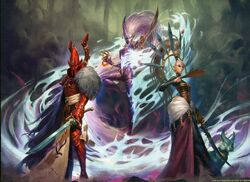
The Triumvirate of Ynnead -- the Visarch, the Yncarne, and Yvraine -- represent a new hope for the Aeldari in the Era Indomitus.
Some amongst the imperilled Aeldari species believe they can be saved from the brink of oblivion by the awakening of Ynnead, the Aeldari god of the dead. By harnessing the strange spirit magic of this rising deity and drawing upon the energies of the Aeldari dead, they wage their crusade with exceptional vigour and aggression.
It has been said for millennia that the Aeldari pantheon of gods is long shattered, destroyed by their mortal followers' hubris and the galactic terror that is Slaanesh. The ascension of She Who Thirsts was a cataclysm of galaxy-splitting magnitude. In a single instant, the psychic shock wave of the Dark God's birth destroyed the most part of the Aeldari Empire and triggered a permanent Warp Storm of unprecedented size -- the Eye of Terror.
But the true doom of the Aeldari came in a more insidious form. As the Asuryani tell it, their metaphysical cycle of reincarnation into new bodies after their souls passed into the Warp for a time was severed by the violence of Slaanesh's birth, and the gods that once ruled over them were consumed. After a titanic duel with Slaanesh, Khaela Mensha Khaine -- the Aeldari god of war -- was shattered into a thousand pieces that would take refuge in the Infinity Circuits of the craftworlds.
The others members of their pantheon, barring the Laughing God Cegorach, were devoured by the newly emergent Slaanesh. From that point on, when an Aeldari died, their soul would enter the Warp and likewise be consumed by She Who Thirsts, a destiny far worse than mere oblivion.
The various factions of the Aeldari have sought ways to escape this fate, or at least allay it for a time. The Asuryani, for instance, wear psychocrystalline Waystones that act as safe havens, absorbing their souls upon the moment of death.
Later these Spirit Stones are interred within a craftworld's Infinity Circuit, allowing the soul to transfer to a construct of relative safety and from then on spend existence in a safe but lifeless grey limbo.
The Drukhari instead ensure others suffer in their stead, drawing on the psychic energy emitted by their pain to perpetually lengthen their lives. This is a devil's bargain that only postpones their inevitable consumption by Slaanesh. Small wonder that many Aeldari hailing from either faction were quick to seize on the possibility that there was another way to evade their nemesis -- and perhaps conquer it forever. This they called Ynnead.
There is an ancient and controversial school of thought regarding mortality in Asuryani society, recently brought back to prominence by the prophecies of Kysaduras the Anchorite. It posits that when every one of the Aeldari species has died and passed into the Infinity Circuits of the craftworlds, their departed spirits will form a gestalt consciousness. In doing so they will awaken and empower a new Aeldari god, a deity of the dead with the power to defeat Slaanesh and end She Who Thirsts' baleful curse.
Some amongst the Asuryani claim that though the time of ending is nigh, not all Aeldari must die to escape Slaanesh's clutches -- that there is a hidden path to be found amongst the darkness. Foremost amongst these is Eldrad Ulthran, the High Farseer of Craftworld Ulthwé.
Upon the crystal sands of the moon of the Imperial world of Port Demesnus, Coheria, Eldrad put into motion the grand plan that would alter the course of his people's destiny. Under the cover of their roving visitations, the Harlequin Masque of the Midnight Sorrow -- acting on the instructions of Eldrad -- abducted the crystallised bodies of long-departed Farseers from each Asuryani craftworld's Dome of Crystal Seers. These they took to Coheria, for Eldrad had identified the moon as a site of extreme psychic potential.
By harnessing Coheria's pure crystal sands and using each grain as a miniature Spirit Stone, Eldrad intended to perform a grand ritual wherein he would summon every departed spirit from every craftworld at the same time. The stolen Farseers' crystalline remains would provide potent hyperspatial links -- though the transfer would rob all power and light from the donor craftworlds for a time, Eldrad judged the sacrifice worthwhile.
With such a vast concentration of departed souls in one place at one time, the High Farseer intended to awaken Ynnead prematurely and set him against the Aeldari's eternal nemesis.
Perhaps, if Eldrad's machinations had been completed, he would have succeeded in his immensely ambitious plan. But the elite Imperial xenos-hunters of the Deathwatch had followed the actions of the Ulthwéans for many Terran years. Led by the prescient Brother-Captain Artemis, they launched a sudden strike against Eldrad and his allies just as he was conducting his grand ritual.
Forced to protect himself from a searing plasma blast, the High Farseer lost focus. In the swirling tides of the Warp, the composite sentience of slumbering Ynnead stirred, but did not awaken. From that partial apotheosis a fragment of the greater consciousness was born -- an animus that soon possessed a warrior-dancer known as Yvraine who was fighting in the arenas of Commorragh. She became the high priestess of a new Aeldari religion, and has since led her followers across the stars, uniting Asuryani and Drukhari behind her as she goes.
After becoming invested with Ynnead's power during what became kwown as the "Night of Revelations," Yvraine became able to draw the departing Aeldari souls of those around her into herself, where they live on -- not as half-real revenants or echoes of a former glory, but as willing allies. To outsiders, it seems as if Yvraine is talking to herself, listening to voices only she can hear, or changing personality in a heartbeat.
Those who do not know of her creed think her insane, but the Ynnari know the truth: Yvraine's body harbours not just her own soul, but many others.
The Ynnari or "Reborn" who follow Yvraine's lead -- the devoted warrior known as the Visarch and the dread Avatar known as the Yncarne foremost amongst them -- share her uncanny ability. They wear the Spirit Stones of the dead upon their person,drawing upon the energy and wisdom of the departed in times of need. With the doom of the Aeldari close at hand, their need for that deathly strength is greater than ever before.
Notable Events
The once-glorious history of the Aeldari is preserved only in myth; most of the truths of ages past have long been lost. In the millennia since the Fall, the Craftworld Aeldari have been locked in an endless struggle to survive, and they have no choice but to fight with every weapon at their disposal.
- An Empire Ascendant (ca. M15 - M20) - The Aeldari Empire reaches its zenith in terms of territory acquired and cultural and technological achievement. The Eldar of this age refer to themselves by their original species name of "Aeldari."
- Darkness Rising (ca. M18 - M30) - Throughout the Aeldari civilisation, a profound degradation in moral discipline sets in. Over the Terran millennia, there is a gradual slide into sensual excess. With the rise of the Cults of Pleasure, the worship of the Aeldari gods declines. Slowly, the foundations of the once-great empire start to crumble. As the Aeldari's quest for excess crosses the line into outright evil, a perverse new god begins to form in the Warp.
- The Hidden Kin (ca. M18 - M20) - The Aeldari Cults of Pleasure slowly take over the lawless port-cities of the Webway. Many of the leaders of the Aeldari Empire are among them. The largest and most influential, Commorragh, becomes synonymous with vice. The forefathers of the Drukhari are born.
- A Sickness of the Spirit (ca. M18 - M29) - The sheer luxury and indolence of the technologically advanced Aeldari Empire breeds a combination of curiosity and complacency amongst the Aeldari.
- The Great Exodus (ca. M30 - M31) - Those Aeldari able to see the rotten core of their empire for what it truly is flee. First to leave are the Exodites, followed not long after by the Craftworld Aeldari.
- Fall of the Aeldari (ca. M30 - M31) - The core of the Aeldari Empire is consumed by the cataclysmic birth-screams of the Chaos God Slaanesh. Trillions of sentient beings die as the centre of the empire -- over a thousand worlds -- collapses into the Immaterium, leaving the Eye of Terror and the Crone Worlds in its place. The unified Aeldari civilisation shatters, and the psychic backlash of Slaanesh's ascendance curses the immortal souls of all those Aeldari who survive to be subject to consumption by the Dark God upon death. The survivors of the Fall, regardless of faction, begin to refer to themselves as "Eldar" to mark the loss of their past. The Aeldari species' long battle against extinction begins.
- The Rise of Humanity (ca. M30 - M31) - The Warp Storms isolating the Human homeworld of Terra are swept away by the violence of Slaanesh's birth and the Emperor of Mankind unites Humanity in conquest during the Great Crusade under the aegis of the newborn Imperium of Man. Their stranglehold on space travel broken, the Aeldari are powerless to stop it.
- The Pride of the Phoenix (ca. M31) - Farseer Eldrad Ulthran of Craftworld Ulthwé contrives a parley with Fulgrim, the primarch of the Emperor's Children Legion, to warn him of the tendrils of Chaos already corrupting the Legiones Astartes. Tragically, the Asuryani's warnings fall upon deaf ears. They remain largely uninvolved in the great slaughter of the Horus Heresy that ensues.
- The Shattering of Lugganath (764.M34) - The Emperor's Children Traitor Legion ravages Craftworld Lugganath in Slaanesh's name, killing thousands of Eldar before the hedonistic Chaos Space Marines are repelled.
- The Ghoul Star Supernova (818.M35)
- The Ghostly Harvest (334.M36) - Twelve Alaitoc Wraithknights plunder Waystones from the ruins of Belial IV. The cavorting daemon hosts of the Crone World in the Eye of Terror attack in force, but the Eldar are able to forge a path back to their Webway portal and escape unharmed.
- War in the Webway (514.M38) - The Craftworld Eldar of Ulthwé and the Dark Eldar Jade Knife Kabal of Commorragh battle for dominance within the shattered spars of the Webway. An uneasy truce is called only when the death toll becomes unbearable for both sides.
- A Cruel Thirst (487-492.M39)
- The Sons of Khaine (741.M41) - A conclave of Autarchs decide the "lesser races" of the galaxy must be shown their place, leading to a great surge of Eldar taking the Path of the Warrior.
- The Coming of the Great Devourer (745.M41) - The Seers of the Eldar lament as the true magnitude of the encroaching Tyranid Hive Fleets becomes horribly clear.
- Maedrax Stirs (783.M41) - Eldrad Ulthran brings about the destruction of the Necron Tomb World of Maedrax before Imperial Explorators awaken it fully. In doing so, the Eldar uncover a vast Necron Dynasty that spans the star system.
- The Death of Gnosis Prime (786.M41) - Autarch Zephyrblade's warhost sweeps down upon the Imperial world of Gnosis Prime, outmanoeuvring its lumbering human armies at every turn. In alliance with Dark Eldar raiders, the Autarch sees the world brought to the brink of destruction.
- The Hounds of Khorne (794.M41) - Caelec the Wanderer, a famed Eldar explorer, breaches a sealed runic portal, only to find it leads to Khorne's realm. A warband of hound-headed fiends, Flesh Hounds, slays Caelec and follows his scent to his home Craftworld of Yme-Loc, causing utter carnage before it is finally banished to the ether.
- Fist of the Machine God (801.M41) - When Craftworld Yme-Loc refuses to yield its technological secrets to an Adeptus Mechanicus war fleet, battle breaks out within the armouries of Vaul. Millions die before the Tech-priests seize enough advanced Eldar technology to sate their predatory curiosity for forbidden xenostech.
- The Doom of Malan'tai (812.M41) - The Craftworld Malan'tai was destroyed by a splinter of the Tyranid Hive Fleet Naga and was the location of the first known encounter with the potent Tyranid Zoanthrope later called the "Doom of Malan'tai" by the Eldar. The derelict Craftworld became nothing more than a drifting, lifeless husk floating through the void. In 994.M41, Craftworld Iyanden came to Malan'tai to see if its people could find anything of use to help with repairs of their home after their recent battle with Hive Fleet Kraken, but instead, they found the abandoned Craftworld swarming with vile Orks. When the Eldar finally regained control of Malan'tai, they discovered that the Orks had stolen or destroyed anything of use. With heavy hearts, they altered the abandoned Craftworld's course towards the nearest sun and headed home.
- The Twin Betrayals (845.M41)
- The Perfect War (891.M41) - Upon the sludge-planet of Yurk, an army of Orks is engaged and destroyed by Craftworld Iyanden without Eldar loss. The pinpoint precision of the Eldar assault prevents the Yurkoid WAAAGH! and saves a virgin Eldar colony from destruction.
- Scorpion's Sting (928.M41) - Karandras duels his predecessor as Phoenix Lord of the Striking Scorpions Aspect Warriors, Arhra, the Father of Scorpions, in the ruins of the lost Craftworld of Zandros.
- Roar of the Beast (941.M41) - Whilst preventing a WAAAGH! that would have strayed into the path of Craftworld Idharae, Eldrad Ulthran of Ulthwé raises the Ork Warlord Ghazghkull Thraka to prominence, capsizing a huge swathe of the Imperium in the process.
- Time of Ending (991.M41) - The Eldar mystic Kysaduras the Anchorite proclaims the End Times to have begun. After lengthy meditation alongside Eldrad Ulthran of Ulthwé, he preaches to the High Seers of that Craftworld that the Eldar's only hope of survival lies with the awakening of Ynnead, the nascent Eldar God of the Dead.
- The Doom of Iyanden (992.M41) - Craftworld Iyanden is locked in a death-struggle against Hive Fleet Kraken. As the Craftworld teeters on the brink, the infamous Eldar Corsair Prince Yriel rallies the desperate defenders and slays the monstrous Hive Tyrant leading the invasion, saving his people.
- Sanctity Breached (998.M41) - At great cost, the Eldar defend the sacred Black Library in the Webway from the Chaos Sorcerer Ahriman of the Thousand Sons Traitor Legion who seeks to claim its vast knowledge of Chaos for himself.
- The Bio-Purge (778.999.M41) - Using the Dark Eldar device known as the Fireheart that was capable of destroying the core of a planet, Craftworlds Biel-Tan and Iyanden unite in an uneasy alliance with their dark kin of Commorragh in the incineration of Dûriel and dozens of Imperial and Ork-held worlds within the Octarius System. In doing so, they deny Hive Fleet Leviathan precious biomass and bring about the destruction of one of its tendrils.
- Chaos Ascendant (999.M41) - Abaddon the Despoiler, the Warmaster of Chaos, launches the greatest invasion of realspace ever seen, his 13th Black Crusade. Ulthwé has waited long for this moment, and leads the Craftworlds to war. The Eldar cause horrific damage to the Chaos Space Marine Traitor Legions on dozens of worlds, suffering untenable casualties in their turn as the minions of the Great Enemy fight back. The death toll rises ever higher, with no end in sight.
- Rise of the Phoenix (999.M41) - The Eldar Phoenix Lords gather together for the first time in millennia.
- The Awakening of Ynnead (999.M41) - Ynnead, the Eldar God of the Dead, awakens within the Warp due to the actions of the Farseer Eldrad Ulthran on the crystal moon of Coheria at the Battle of Port Demesnus and chooses Yvraine, the Daughter of Shades, a child of both the Craftworlds and Commorragh, as his priestess and prophet. She founds a new Eldar faction, the Ynnari, the "Reborn," and for the first time since the Fall unites members of all the Eldar cultures under one banner. She calls on the Eldar to revive the legacy of the Aeldari and even to readopt the ancient name of the race for their own. For the first time in 10,000 Terran years, the Eldar dare to hope that the future offers more than extinction...
Asuryani Technology
No other intelligent race of the Milky Way Galaxy has ever replicated the Aeldari's unique approach to technology, nor have the Aeldari applied knowledge from the "primitive" races that have inherited the galaxy in the wake of the fall of their empire. The brutality and ignorance of Mankind appalls the Asuryani, whilst in return the aloof arrogance and fickle nature of the Aeldari race fosters little trust in others.
Asuryani technology adheres closely to natural biological shapes and structures. This is quite understandable, as there is no real difference between technology and nature in the Aeldari mind -- they are a single process by which the Aeldari imbue living things with function and functional things with life.
The materials the Asuryani use in their engineering are complex and varied ectoplastics that can be formed into solid shapes under psychic pressure. In some respects they are more like living tissue than inert substances, growing and reacting to their environment in a similar way to plants. The completed device or artefact may work in a conventional manner, but it is always operated by psychic means.
The greatest of the materials the Asuryani employ is called wraithbone: an immensely resilient substance that is grown rather than made, more resilient than adamantium and far more flexible. When a wraithbone construct is damaged, it will gradually repair itself, a process that can be accelerated by the psychic chanting of an artisan known as a Bonesinger. Because of this, the greatest Asuryani war-constructs and the craftworlds themselves are made almost entirely from wraithbone, giving them extreme durability and strength.
As part of their potent psychic inheritance, one ability common to many Asuryani is called psychomorphism by the Human magi biologis of the Adeptus Mechanicus. In crude terms, this gives the Asuryani the psychic ability to shape matter and create simple artefacts from basic raw materials.
More complex items can be made by several individuals with the ability working together or with the aid of forging machines that enhance the creative process. Asuryani can also move small objects using a form of psychokinesis and it is by this means that they build their most sophisticated devices.
Some Asuryani can influence the structure of growing matter by a form of empathic telepathy. This empathic ability may have been particularly important during the early development of the Aeldari race, enabling them to promote the fertility and fruitfulness of edible crops and reshape the growth of trees to make simple shelters.
During their primitive evolutionary stage, the Aeldari undoubtedly benefitted greatly from these abilities. The first Aeldari villages and towns are supposed to have been living structures grown from trees, often covering many square Terran kilometres and reaching high into the air. Structures like this can still be found on worlds colonised by the Aeldari Exodites in later times and aming the ruined cities of the lost Crone Worlds of the Aeldari Empire in the Eye of Terror.
Because of their natural psychic abilities, the Aeldari learned how to make and shape raw materials at a very early stage of cultural development. By means of their mental abilities they were able to refine materials and shape the resulting metals and stone into whatever they desired. Asuryani technology thus has a very ancient history and the pace of its progress was closely tied to the slow overall evolutionary and cultural development of their species.
There was never a sharply defined industrial phase of Aeldari history, as there was for the Humans of Old Earth during the Age of Terra, but rather a steady growth in competence and knowledge over a very long period of time.
A particularly Aeldari aspect of all their technology is that its forms often adhere closely to natural biological shapes and structures found in the living world, as noted above. This is quite understandable, as there is no real difference between inorganic technology and nature in the Aeldari mind as there is to Humans -- they amalgamate into a single process by which the Aeldari imbue living things with function and functional things with life.
Unique Asuryani Technology
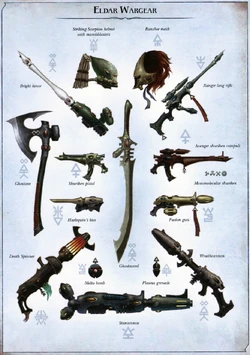
Selected Asuryani Wargear
- Asuryani Wargear
- Shuriken Weapons - The standard weapon of the Asuryani military forces are shuriken weapons, armaments that use gravitic forces to fire thin discs only a single molecule thick at the enemy. These discs are so thin that they are usually fired in bursts. The Asuryani use these weapons in the form of pistols, cannons, and a light carbine known as a Shuriken Catapult.
- Spirit Stones - When the Aeldari die, their souls are in danger of being devoured in the Warp by the Chaos God Slaanesh. To prevent this, the Asuryani created special Spirit Stones, which capture and contain the psychic energy that comprises their souls at the moment of death. These stones are then collected and inserted into a craftworld's "Infinity Circuit", where they may rest along with the spirits of their ancestors. In times of need, the Spirit Stones of the craftworld's strongest warriors may be taken from the Infinity Circuit and placed inside wraithbone automatons such as the Wraithguard, Wraithlord and Wraithknight, to once again fight in defence of the craftworld, though most Asuryani find this process deeply distasteful and akin to necromancy.
- Webway - The Asuryani cannot travel through Warpspace in the same way the starships of the Imperium do, because they lack the equivalent of Navigators, making the trip extremely dangerous for a journey of any more than a few light years at a time. Instead they rely on a system of transportation through the Warp known as the Webway. The Webway is best imagined as a vast and tangled network of doorways connected through the Warp between fixed points in realspace, by which the Asuryani can travel far more rapidly than most other starfaring races.The Webway's technology is based on that of the Old Ones, who first developed a very similar system of transportation using Warp Gates and imparted the technology to the Aeldari after their creation. However, if there is not a Warp Gate near an Asuryani's destination, or the one present is not big enough to permit the necessary forces to pass through, they are at a disadvantage. Much of the Webway has fallen into obscurity and disrepair, with tunnels and doorways sealed or broken. This often forces the Asuryani to make connecting stops on their way to their destination. Finally, it is said that the fabled Black Library, a hidden craftworld that serves as a storehouse for all the accumulated knowledge of the Aeldari about Chaos, resides somewhere within the Webway, though only the Harlequins know exactly where.
- Wraithbone - This is the main construction material of the Craftworld Aeldari, and the staple of their psycho-technic engineering. It is brought forth into the physical world from the Warp and shaped by Bonesingers through the use of their well-trained psychomorphic power. It is used to create the craftworlds of the Asuryani, their tanks and other vehicles, constructs such as the Wraithguard and Wraithlords, as well as their weapons, tools and armour. Wraithbone is a psychically conductive material and so not only provides the structure for things built of it, but also can be used for power distribution and communications. Wraithbone is a highly resilient material, and capable of limited self-repair when exposed to psychic energy. It, and the other building materials of the Asuryani, will grow and react more like organic tissue and plants than the inorganic building materials of other races.
- Blackstone Fortress (Talisman of Vaul) - The Blackstone Fortresses were originally created by the Old Ones as weapons in the first war against the C'tan, and were known to the ancient Aeldari as the "Talismans of Vaul." To capitalise on the C'tan's vulnerability to psychic attacks using Warp energy, the fortresses were equipped with a Warp-cannon that could create a devastating rip in physical space and an eruption of psychic energy out of the Immaterium. The fortresses have since fallen into the hands of the Imperium and the Chaos Space Marines, and have influenced two of the most recent major wars of the Imperium of Man, including the Gothic War and the 13th Black Crusade.
Remnants of Glory
Remnants of Glory are items of incredible rarity and power, each one an echo of the ancient Aeldari Empire's might. During times of great need, each craftworld brings out even the most prized of artefacts from their armouries.
- Kurnous' Bow - Aeldari myth recounts how Kurnous hunted across the stars and fashioned an arrow specific to each prey he sought. When loosed from his bow, these slaying missiles would seek out the weakness in their target, finding gaps in defences to reach the soft flesh beneath. Kurnous' Bow is a Shuriken Pistol created long ago in honour of these ancient tales. Its psycho-sympathetic ammunition reacts to the vulnerabilities of the foe, turning a shot that should have merely wounded into a killing blow.
- Shard of Anaris - When the war god Kaela Mensha Khaine slew the mortal warrior Eldanesh, he took the sword Anaris and claimed it as his own. When Khaine was shattered in battle with Slaanesh within the Warp, Anaris too was splintered, the fragments of both blade and wielder coming to rest within the craftworlds. Legend tells that the Shard of Anaris was then crafted into a blade to be borne by the Aeldari's mightiest warriors.
- Uldranorethi Long Rifle - Uldanoreth was an Asuryani Outcast whose wanderlust drove him to tread the stars. He braved the dangers of a thousand worlds, surviving only on his wits and ingenuity. Whilst on his long journeys, Uldanoreth perfected the art of the long-range attack, and crafted a formidable weapon capable of sniping enemies from incredible distances.
- Faolchú's Wing - When the mortal warrior Eldanesh fell battling Khaine, the great falcon Faolchú, Eldanesh's companion, was disconsolate. Faolchú gifted a single golden pinfeather to Eldanesh's heirs, that perhaps its swiftness might aid them where her own had failed. Legend tells that this artefact Jump Pack is that selfsame token of grief, handed down through generations of Aeldari, and surviving even the tumult of the Fall of the Aeldari.
- Firesabre - Many legends speak of Draoch-var, the great drake whose ethereal fires reduced the great forests of Velorn to inert ash, and whose wrathful strength toppled the pillars of the Temple of Isha. Reputedly, this Aeldari power sword was forged from Draoch's razored fang in celebration of Ulthanesh's victory. It burns with a fury that can never be quenched, and its fire spreads like a living thing.
- The Phoenix Gem - At the height of the War in Heaven, Asuryan himself was laid low by the chill blades of his foes. To save her beloved, Isha drew down the heat of a hundred stars into a glittering gem. The light and heat that had once nurtured countless planets drove the unnatural chill from the Phoenix King's bones and returned him to his people and his consort. It is said that the Phoenix Gem is the only surviving fragment of this ancient stone. Even now, millions of years hence, it can still return life to the fallen...
- The Spirit Stone of Anath'lan - Anath'lan was once one of Craftworld Biel-Tan's most skilled Farseers. Alas, pride caused him to misread the runes, dooming a Maiden World to a bitter demise. Unable to forgive himself, Anath'lan died of grief. His Spirit Stone refused to bond with the Biel-Tani Infinity Circuit, and to this day guides other Asuryani psykers away from the error that led to his own disgrace.
- Swiftshroud of Alanssair - Long before the first cameleoline cloak there was the Shiftshroud of Alanssair -- a garment that didn't so much camouflage or obscure its wearer as shift them from their plane of existence. Made using secrets gleaned from starfarers far more ancient than they, anyone wrapped in its fibres could all but disappear from plain sight. At one time some dozen such Shiftshrouds could be found preserved beneath crystal in Alaitoc; now, all but one remains, the others lost to the ages. Should a commander of Alaitoc have need of this powerful relic, they will withdraw it from the world-ship's deepest vault.
- Burnished Blade of Aliarna - The Aeldari hero known as Eliarna predates the Fall by many thousands of Terran years. As the tale is told, she was the greatest of warriors -- a precursor to the Howling Banshees with her finely honed bladecraft. To combat the Ork menace that beset many Aeldari kingdoms, Eliarna had forged a weapon imbued with eldritch properties especially deadly to the greenskins. Made of some unknown metal, this power sword gleams like a star, and the quiet hum of its energy field rises in volume in the presence of Orks. To this day, the Burnished Blade of Eliarna is still used by the greatest of warriors of Biel-Tan, and the weapon's keen blade still thirsts for Ork blood.
- Psytronome of Iyanden - The Asuryani psychic engineers known as Bonesingers are patient artisans who understand that true craftsmanship takes time. Growing and shaping wraithbone is both art and science, and cannot be rushed without ill effects. Yet the times have grown dire, and needs dictate that the artefact known as the Psytronome be removed from beneath its dome of preservation on Iyanden and taken to battle. Very much a weapon of last resort, the small pendant pulses when activated, resonating at such a frequency that its vibrations echo through all realms, including the Warp. For reasons unknown, this regular thrum boosts the growth and vitality of wraithbone, but such unnatural vigour comes at a cost. After an unprecedented burst of energy, the wraithbone becomes brittle, often cracking open.
- Novalance of Saim-Hann - To earn the right to bear the Laser Lance called the Novalance, a Saim-Hann warrior must win the clan challenge known as Tionchar. To all appearances, the weapon appears like any other of its kind, yet upon impact the release of pent-up energy burns brighter than a sun. A single blow from this fabled weapon has shattered battle tanks and toppled even Space Marine Dreadnoughts.
- Ghosthelm of Alishazier - The millennia-old Farseer Alishazier of Ulthwé harboured a deep terror that she would one day join the ranks of her crystallised predecessors. Unable to accept such a fate, she invested her psyche into the circuitry network of her ghosthelm, so that her spirit might forever keep others walking her Path of the Seer safe from harm.
- Blazing Star of Vaul - The Bonesinger Keáirde was the most famed of the weapon smiths from before the Fall, and his works have never been duplicated. The shuriken fired from Shuriken Weapons he crafted are infused with his peerless spirit, and leave contrails of light in their wake. So rapidly can they shoot that it is akin to a meteor storm, and to this day the few surviving weapons of his craft are still known collectively as Blazing Stars of Vaul.
- Shimmerplume of Achillrial - Achillrial was a fearless champion of great renown and one of the first of the Asuryani Autarchs. Upon his appointment to the Path of Command he was gifted a helm that could capture light itself, its resplendent plume reflecting colours like a sun-splashed prism. Blinded by his glory, none could best Achillrial in close combat, and although his radiance drew an inordinate amount of the enemy’s fire, no shot could fell him. It was treachery that ultimately bested Achillrial and led to the downfall of his craftworld of Féin-Cineál. Of that worldship, only the Shimmerplume of Achillrial remains.
Asuryani Path
As protection against the lure of excess, and to guard against any recurrence of the Fall of the Aeldari, the people of the craftworlds adhere to a set of strictures known as the Asuryani Path. Through the rigid emotional discipline of the Path they master their inclination towards sensation-seeking, instead focussing their prodigious intellects and energies upon the pursuit of one specific goal.
Since the Fall, those Aeldari who fled upon the craftworlds have faced their inescapable doom. The battles they have fought in the name of survival have been many and violent. Yet their most important struggle is a spiritual one, for the nature of their psyche remains fundamentally unchanged.
As ever they were, the Asuryani are prone to emotional extremes. Perhaps the greatest difference between the ancient Aeldari and their descendants is that the craftworlders have learned to fear wanton experience, shunning the indulgences of the past. To ensure temptation is put behind them, the philosophy often called Ai'elethra, or "the Path," governs every aspect of Craftworld Aeldari life, enabling the Asuryani to harness their emotional and intellectual intensity safely, without jeopardising themselves or those around them.
In adult life, every Asuryani chooses for themselves a discipline that they then make their task to master to the exclusion of all else. Each discipline is a Path unto itself, and each Path may necessitate further choices and specialisations. Once an Asuryani has walked a Path for long enough, they choose another, then another. Though they forsake each Path in turn, their soul is nourished by the experiences upon it.
An Asuryani may tread many different Paths in their life, and the skills they learn on each journey serve to enrich further accomplishments. To the Asuryani, all avenues of experience are strewn with dangers, for their minds are capable of depth and understanding that goes beyond the concept of mere Human obsession.
Such dangers are often likened to traps or nets, waiting to catch the unwary and hold them fast in the chains of compulsion. When an Asuryani's mind becomes so completely focused upon one thing that they can no longer make the change to another discipline, they are said to be lost upon the Path.
This is a frightening and final fate for all Asuryani, and it can befall any of their kind despite the discipline and training that they receive. In the case of the Path of the Warrior, these individuals are called Exarchs, though there are examples that correspond to other Paths, such as the Farseers and the doomed Bards of Twilight.
There are innumerable Paths open for an Asuryani to explore; some as common as the Path of the Artisan, others as rare and dangerous as the Path of the Seer. Each offers its followers a complete way of life.
Those Asuryani who have mastered the less esoteric Paths are no less respected than their brethren. After all, the artisans are those who create the craftworlds themselves and their contents, calling masterpieces into being with the care a musician lavishes upon their harp or a warrior upon their sword. It is from the ranks of those upon "civilian" Paths such as these that the Guardian militia are mustered in times of need.
Path of the Warrior
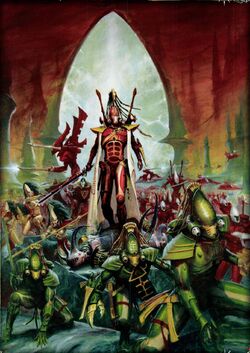
A craftworld's Aspect Warriors defend their world from encroaching enemies
The Aeldari are a race beset on all sides by warfare. Would that it were not this way, for Aeldari generations are few and far between, and they can ill afford to lose their numbers. Young Asuryani often believe they can rebuild the glory of their empire with fire and passion, but their elders know well that their shattered civilisation is locked in a struggle for simple survival.
Because of this unavoidable truth, more and more Asuryani walk the Path of the Warrior with every passing year. The Path of the Warrior teaches the arts of death and destruction. Such is the dark nature of the Aeldari psyche that the Warrior Path draws most of them onto it at some point in their long lives. In aeons past, the ancient Phoenix Lords taught the arts of war to both males and females, and as a result Asuryani warriors are as likely to come from either gender.
As with many of the more complex Paths, the Path of the Warrior is divided into many separate branches. Each of these is known as a Warrior Aspect, representing a different facet of the war god Khaine, and bringing with it unique fighting techniques, weapons and abilities. The Aspects differ greatly in their methods of warfare, and offer specialist skills for specific battlefield roles.
Each Aspect upon a craftworld keeps at least one shrine in which to practice the mastery of their Warrior Path. When the Asuryani go to war, the Warrior Aspects fight in a predetermined role associated with their shrine. They have their own warrior garb, a form of ritual battle suit, and distinctive weaponry, ranging from the Fusion Guns of the Fire Dragons to the sleek Nightshade Jetfighters of the Crimson Hunters. Their minds and bodies are honed with endless exercise, both physical and spiritual, until they become suffused with the aspect of Kaela Mensha Khaine that their shrine represents.
The Aspect Warriors do not all live in the shrines, and when they put aside their ritual masks and uniforms, they can walk at peace through their craftworld.
Only the keepers of each shrine, the Exarchs, live within them, unable and unwilling to escape. Some Aspects, such as the Slicing Orbs of Zandros, are unique to a specific craftworld.
Others are common to most, with the most famous and well-established being the Dire Avengers, the Howling Banshees, the Striking Scorpions, the Fire Dragons, the Swooping Hawks, and the Dark Reapers. In battle, each unit plays its own part with the skill of a virtuoso, their singular abilities combining in a symphony of destruction that is far greater than the sum of its parts.
From the most numerous horde to the mightiest enemy war machine, there is a cadre of the craftworld's warriors with skills and weapons suited to its annihilation. Combined with the prescience of the Farseers and the strategic genius of the Autarchs who command the warhost, even a small strike force can devastate its opponents with little fear of reprisal.
The Asuryani ideal is to eradicate those who oppose them without a single loss from their own ranks, for the usurpers are many and the Asuryani few. They cannot afford to throw away their lives in the manner of the cruder races they face.
Every Asuryani lost in battle will have been sacrificed because there was no other choice, and at great cost to the enemy, for in comparison the lives of other species are worthless.
Path of the Outcast
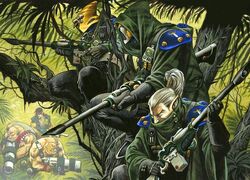
Asuryani Rangers stalking an unsuspecting foe.
Sometimes the rigid constraints of the Path are intolerable even for an Eldar to bear. Such individuals leave their craftworlds and voluntarily become Asuryani Outcasts. Many Eldar spend Terran years or decades in exile before they return to the Path. During this time, they must bear the terrible burden of their heightened consciousness without the protection of rigid self-discipline. Their psychically-sensitive minds are a beacon to predatory daemons and in particular to the Great Enemy Slaanesh, so only Eldar of especially strong character can survive for long. After years of adventure, wandering, and sailing the seas of space, most Eldar eventually return to the sanctuary of the Path.
There are many kinds of Outcast, each with a varying degree of dissociation from their kin. They leave their craftworlds to carve out lives elsewhere, often wandering the galaxy and visiting the worlds of Men or the Exodites of the Maiden Worlds. These inscrutable nomads are welcome aboard Craftworlds only briefly, for their minds are dangerously unguarded and can attract predators from the psychic realms of the Warp. Outcasts are also disruptive in another sense, for simply by their presence they can distract the young and inexperienced from the Path, as romantic tales of travel and freedom follow in their wake. Some Eldar yearn for the undiscovered vistas of open space. They join fleets of exploration and disappear into the untrammelled warp space tunnels of the webway. Most do not return, though a few come home laden with alien treasures. They bring tales of new worlds, fabulous discoveries, and battles on the edges of the galaxy.
The wildest of all the spacefaring Eldar become Corsairs and raiders. They often continue to trade with and visit their craftworld whilst plundering the ships of humans, Orks and even other Eldar. These mavericks may even sometimes hire out their services to alien races, while many a voyage of exploration has turned into a military venture. As home -- and the Eldar Path -- become increasingly remote, the naturally wild and amoral character of the Eldar resurfaces. Eldar pirates are quick-tempered and unpredictable, equally inclined to magnanimity and wanton slaughter. Fleets such as the Eldritch Raiders, the Steeleye Reavers and the Sunblitz Brotherhood are greatly feared as a result.
To the ignorant, there is little to distinguish between the ships of the Craftworlds, the Corsair fleets of Outcasts and those of Dark Eldar pirates. All are seen as a constant, elusive menace that bring sudden death to the unwary. On occasion, Corsair fleets will join with the ships of a Craftworld in response to a common threat, while at other times a Craftworld may aid its Corsair cousins on a mission of war, all of which adds to the illusion that the Eldar as a whole are little more than a race of piratical raiders hell-bent on indiscriminate slaughter.
Other Paths
While the Seer and the Warrior are two of the most visible Paths of the Eldar, there are hundreds of others. Many Eldar will choose the study of an instrument or art form as their Path, while others might devote themselves to the development of a science or the refinement of some technology. These Paths, while equally important to the survival of the Eldar, tend to be far more varied and far less all-consuming than those of the Seer and the Warrior. Notable among the other Paths is that of the Bonesinger; the title given to those that maintain and repair the psycho-active Wraithbone components of the Eldar Craftworlds. Also notable is the Path of the Mariner, the Path followed by those who devote themselves to crewing spacecraft.
Warhosts
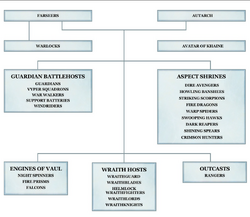
Hierarchy of an Eldar warhost
Like the shimmering blade of Khaine, Eldar warhosts carve through the ranks of their enemies. Guided by the military genius of their Autarchs and the prescience of their Farseers, they turn their minds to war with a single deadly purpose, dispatching their foes with blistering speed and masterful skill. Grace in battle and merciless efficiency are prized virtues of Craftworld Eldar armies. Eldar warhosts are led by those who epitomise such traits: the Autarchs. These are Eldar who have walked the Path of the Warrior for decades or even centuries, yet resisted the taint of Khaine’s red madness. Theirs is a vital role, for the Autarchs alone tread the esteemed Path of Command. If the Autarchs are the hand that grips the blade, then it is the Farseers who guide its aim. The bond between Autarch and Farseer can shape a warhost, and even if neither takes to the field directly, it is their combined vision that will be the difference between victory and defeat.
Though some Eldar warhosts still comprise only Aspect Warriors, the millennia have taken their toll, and it is now all too common for warhosts to rely upon a core of Eldar Guardians, those who through necessity have donned the mask of the killer despite their Path being one of peace. It is a testament to the Eldars' skill at war that even their citizen militia can overcome the armies of the lesser races. Well motivated and expertly led, even a modest warhost of Guardians can outclass an army many times its size. If in need of a stalwart defence, an Autarch can order Guardian-crewed weapon platforms and eldritch artillery to swathe the battlefield in ash and fire, while Windriders, Storm Guardians and grav-tank squadrons dart in at his behest, providing lightning-swift spears with which to spit his foes. Driven by the peerless skill and obsessive focus of their Exarchs, the warriors of the Aspect Shrines form their own strike forces within the Eldar armies. These are the most adept of all their kin, and Autarchs must use their talents wisely. Like razor-tipped arrows, each one is loosed into the enemy where it might do the most harm. In times of great need, Autarchs can also call upon ghostly legions of wraith-constructs, keen-eyed Rangers, and even the Avatar of the Bloody-Handed God itself. As the 41st Millennium draws to a close, such warriors are forced take the field with disturbing frequency, knowing they must fight, or fade away forever.
Asuryani Craftworlds
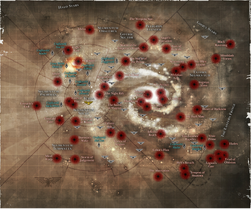
Known Locations of Eldar Craftworlds in the Milky Way Galaxy, 999.M41
In the time leading up to the Great Fall, not all the Aeldari that remained on their empire's homeworlds fell to the lure of perversity and hedonism that birthed Slaanesh. Many remained behind, struggling to turn their species from its doomed path.
Unable to do so, many of the greatest Seers caught glimpses of the darkness to come, and undertook a titanic effort to save their people. For each Aeldari homeworld of the empire a gigantic starship was created, sung from wraithbone and so massive as to be nearly a planetoid in itself. The last uncorrupted individuals from each world were loaded onto these ships, along with works of art, plant life and animals, all that could be saved.
In these so-called "craftworlds" the final Aeldari Exodus began, and only barely in time. The psychic shockwave of Slaanesh's birth in the 30th Millennium caught some of the Craftworlds and destroyed them, while others were pulled into orbit against their will around the Eye of Terror, to be forever assaulted by the forces of Chaos until they are destroyed or corrupted.
The rest drift through the galaxy, their exact number uncertain, as contact can be difficult and intermittent. There are several craftworlds of particular fame known to the Imperium.
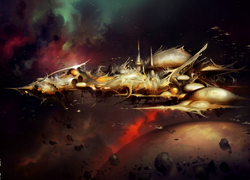
The Craftworld Biel-Tan and its escort fleet.
The craftworlds' populations, a people who call themselves the Asuryani, but were known as the "Eldar" to the Imperium and other outsiders, probably compose the majority of the surviving Aeldari species, although it is impossible to say just how many individuals this is.
The craftworlds are certainly the seat of the remaining Aeldari industry, technology, and culture, as they contain the only vestiges of their original homeworlds' civilisation. Most of the craftworlds contain special biodomes that house plants and wildlife from the original homeworld of the craftworld's people, and these are carefully tended.
Although each craftworld is essentially independent in its actions and governance, they will generally offer and accept aid and advice from one another. Although not common, sometimes craftworld disagreements will cause two to clash on the field of battle, though this is always a last resort.
Every craftworld contains an Infinity Circuit, which is essentially the wraithbone skeleton of the craftworld itself. Within this crystalline matrix of solidified psychic power, the souls of all the craftworld's dead reside in a form of group consciousness, providing both a well of potent psychic power that can be harnessed by the ship during times of distress and a massive ancestral mind to advise and guide the living.
With the rise of Slaanesh, the Infinity Circuit is the closest thing that the Aeldari have to an afterlife; if their souls are not caught and integrated into it, they will be lost into the Warp and devoured by the Great Enemy, whose resonant Chaos energies draw Aeldari souls into itself, much as moths are drawn to a flame.
For this reason, the Asuryani will defend their craftworlds with a fury and tenacity almost unrivalled by other intelligent species; they risk losing not only their home but their very souls as well.
Major Craftworlds
Alaitoc

World-rune of Alaitoc
Far out on the frontiers of the galaxy, on the edge of explored space, lies the Alaitoc craftworld. The Alaitoc Asuryani are zealous in their vigilance against the touch of Slaanesh, even more so than other Asuryani.
Alaitoc is an unusually strict craftworld in making sure its citizens follow the Asuryani Path and other craftworld traditions; in response, many of the more freedom-loving individuals from this craftworld choose instead the Path of the Outcast, becoming Rangers or even Aeldari Corsairs who roam the galaxy and make their living raiding primarily Imperial commerce.
While all craftworlds make use of the Rangers, who are the most highly accurate snipers amongst the Aeldari, none field or produce more than Alaitoc. Though Alaitoc Rangers do not reside upon the craftworld and prefer to travel the galaxy, these Rangers retain their loyalty to Alaitoc and will return to their home craftworld on occasion to visit family and friends.
Aside from deploying large numbers of standard Rangers, Alaitoc is also the only craftworld to field the highly skilled Rangers known as Pathfinders. These snipers without compare can cause havoc amongst even the most powerful and numerous of enemy forces. In times of extreme need, such as when the Imperium of Man's forces invaded Alaitoc, the craftworld sometimes recalls its Rangers to contribute to Alaitoc's defence forces.
Whereas their kin have forgotten their people's duty to watch for the return of their ancient enemies the Necrons, the Asuryani of Alaitoc have not. When the Necrons first began to awaken in the late 41st Millennium Alaitoc was quick to respond, sabotaging the systems of awakening Tomb Worlds, and lending aid to Exodites threatened by their reemerging enemies.
Alaitoc uses a sword rune which represents the Sword of Vaul, the final divine weapon forged in Aeldari myth for the smith god's desperate battle against the war god Khaela Mensha Khaine. It represents the defiance and determination of the craftworld's people.
Alaitoc and its forces are associated with the colours blue and yellow. The craftworld is known to be located in the Ultima Segmentum that was the heart of the ancient Aeldari Empire.
Black Library
The Black Library of Chaos, better known simply as the Black Library, is the secret craftworld that serves as the Aeldari's repository of forbidden lore concerning the Ruinous Powers that exists somewhere within the labyrinthine passages of the Webway.
The Aeldari craftworlds became the only surviving sources of their ancient knowledge of sorcery and the Ruinous Powers of Chaos after the Fall of that race to the birth of Slaanesh.
As the craftwords have drifted apart, this knowledge has consequently become fragmented, and as some craftworlds have become lost over the millennia, more precious Aeldari knowledge has been lost with them.
The Black Library is governed by a body of the wisest Asuryani Farseers drawn from all of the craftworlds known as the "Black Council" and is protected by the masques of the Harlequins as part of their service to the Laughing God Cegorach.
The Black Council is the closet the fractious Aeldari race has come to an advisory body that looks after the interests of the entire race. The Aeldari know more of Chaos than Mankind ever will, and still more was lost during the Fall.
A single source of Aeldari knowledge has remained untouched and inviolate since the Fall. In a hidden location, some say at the very centre of the Webway -- the Aeldari's network of interdimensional tunnels that crosses the galaxy -- rests the tomes, books, scrolls, and codices describing the Aeldari's complete and extensive knowledge of the Warp.
The forbidden lore of the Black Library describes the blandishments, influences, forms, creatures, perils, promises, and horrors of Chaos. The existence of the Black Library is known to only a few and entry is allowed to even fewer individuals.
The library defends itself against the weak and those who would misuse its knowledge by refusing entry to all except those who have acknowledged and tempered the Chaos within themselves. The immature, who are still vulnerable to the promises and seductions of Chaos, find that they are unable to pass through its gateway.
As a result, only the Solitaires of the Harlequin troupes are allowed to come and go freely, although some say that a Human, perhaps an Inquisitor, has also been allowed to do so.
Biel-Tan

World-rune of Biel-Tan
The most martial of the craftworlds, the people of Biel-Tan constantly strive to return the ancient Aeldari Empire to its former glory. For the Asuryani of Biel-Tan the Path of the Warrior, the life-stage that encompasses the Aspect Warriors, is always considered the first step upon the Asuryani Path.
Upon reaching physical maturity a Biel-Tan Asuryani becomes an Aspect Warrior, and only once they have fulfilled this role can they continue along the Asuryani Path.
The Asuryani of Biel-Tan have a strong honour code and believe that the best way to die is in battle fighting the enemies of Biel-Tan and the Aeldari. Consumed with bitterness, they wage an endless campaign of xenocide against those foolish enough to cross their path.
Biel-Tan's armies contain the highest percentages of elite troops of all the craftworlds, and few of the staple citizen-militia called Guardians that most craftworlds call upon in times of war. Their highly-trained forces are known as the Swordwind, and they often come to the aid of Exodite worlds beset by Orks, Drukhari or other xenos dangers.
As the Asuryani of Biel-Tan see it, when the time comes for the Aeldari to reclaim what is rightfully theirs, the paradise Maiden Worlds and the planets of the Exodites will be the first staging points for their conquest.
The world-rune of Biel-Tan is also the Aeldari rune of rebirth and its name actually means the "Rebirth of Ancient Days."
Iyanden
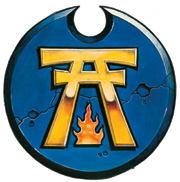
World-rune of Iyanden
The Iyanden craftworld was once one of the largest and most prosperous of all the remaining Asuryani craftworlds. The Iyanden barely survived an attack by the Tyranid Hive Fleet Kraken, which nearly destroyed the craftworld and killed four-fifths of its population.
On the verge of total annihilation, Iyanden was saved from complete destruction by the exiled Aeldari Corsair Prince Yriel, who had formerly been the high admiral of the Iyanden fleet. Yriel and his Outcast Aeldari pirate raiders, even though previously vowing never to return to Iyanden, could not bear to have their home craftworld destroyed and launched an attack on the Tyranid fleet.
The subsequent battles destroyed much of the craftworld's infrastructure. Today many of its sections are still in ruins and the population is spread thinly across its ruined sections.
This forces Iyanden to often call upon the spirits of its fallen in its Infinity Circuit, raising more than the typical numbers of Wraithguard and Wraithlords to aid their dwindling warriors in battle.
Asuryan the Phoenix King is the oldest and greatest of the ancient Aeldari deities. He is the father and king of the gods, the ancestor of all living things.
The world-rune of the Iyanden craftworld means "Light in the Darkness," a reference to the ever-burning shrine that honours Asuryan and the flame of hope for the Asuryani of Iyanden.
Saim-Hann
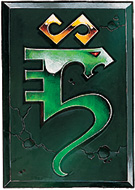
World-rune of Saim-Hann
The Asuryani craftworld of Saim-Hann was one of the first craftworlds to abandon the Crone Worlds as the Fall of the Aeldari approached, heeding their Farseers' warnings.
As such they have spent far more time isolated from the rest of the Asuryani than the other major craftworlds, although the Saim-Hann do maintain contact with and have a very similar culture to the Exodite worlds. They are fierce warriors, who place upon martial honour a higher value than their sophisticated kin.
This, coupled with their pride, has sadly led them into conflict with each other and different craftworlds. While this generally takes the form of an organised duel between representatives of each craftworld in which first blood is usually sufficient to end the matter, the high number of deaths from these conflicts has lent to the barbaric reputation of this craftworld among other Asuryani.
In Aeldari myth, the Serpent is the only creature believed to exist in both the material and the psychic universes at the same time. Hence, the Serpent is said to know all secrets past and present.
Saim-Hann means "Quest for Enlightenment," for the Aeldari word for snake and secret knowledge is identical: "Saim."
The Asuryani of Saim-Hann bear the Aeldari world-rune that represents the Serpent as their heraldry, sporting it on the cowlings of their jetbikes, grav-tanks and aircraft.
Ulthwé
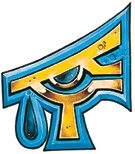
World-rune of Ulthwé
One of the largest craftworlds, Ulthwé was caught in the pull of the Eye of Terror after it erupted into being, and now orbits it. As such it faces a constant danger of attack by Chaos marauders and Daemons and has served as a bastion against the forces of the Dark Gods for thousands of Terran years.
The constant war and risk of attack has hardened the craftworld's citizens, and it maintains a standing militia force known as the Black Guardians, who are highly skilled and better-trained than the Guardians of most other craftworlds.
Its proximity to the Eye has also given Ulthwé an unusually large number of potent psykers, even for the Aeldari. One of the more famous and integral aspects of the Ulthwé craftworld is that of its Seer Council. Formerly led by the now exiled Eldrad Ulthran, who was banished due to his support for the Ynnari, the council both overtly and secretly interferes with other races, particularly Humanity, in an attempt to steer fate in the Aeldari's favour.
This practice has no doubt allowed the Ulthwé to survive so long in such a perilous position.
This craftworld's world-rune, the "Eye of Isha," symbolises the sorrow of Isha, the goddess of the harvest and fertility from whom the Aeldari believe they descend.
Isha, it is said, wept bitterly when Asuryan, the king of the gods, ordered her separation from her mortal children.
Vaul forged her tears into the first glittering Spirit Stones so that her grief might not be in vain and mortals might still be able to commune in some form with the realm of the gods.
Today, the warriors of Ulthwé bear this symbol as their sigil, a poignant reminder of the divinity they lost long ago.
Minor Craftworlds

Rune of Altansar
- Altansar - Altansar is a small Craftworld that had been on the edge of the shockwave that created the Eye of Terror at the time of the Fall. It rode out the psychic shock waves that destroyed the Eldar empire but was subsequently caught in the gravity well of the newborn Eye of Terror. Although the Eldar of Altansar struggled valiantly against the encroachment of Chaos, their doom was inevitable, and within five hundred years of the Fall, their Craftworld was swallowed into the Warp. Amongst the entirety of Altansar's population, only the Phoenix Lord Maugan Ra escaped the Craftworld's consumption by Chaos. Altansar was long thought to have been lost in the birth of the Eye with the other homeworlds of the Eldar. However, there were reports of its sighting and even active involvement in the recently conducted campaign against the Eye of Terror, and doubt now exists as to its fate, though other Eldar will view any citizens of Altansar with suspicion, as no Eldar Craftworld has ever been known to exist within the Eye of Terror for so long without being corrupted by Chaos. The world-rune used by Craftworld Altansar is known as the "Broken Chain" -- not only in reference to the escape of Kurnous and Isha from the dungeons of Khaine, but also to the shattering of the links that bound Vaul to his anvil. The broken infinity loop above the world-rune has only been adopted by the craftworld since its narrow escape from an eternity of damnation within the Eye of Terror.

World-rune of Il-Kaithe
- Il-Kaithe - Il-Kaithe is one of the lesser-known Eldar Craftworlds. Being located close to the Eye of Terror, the Eldar of Il-Kaithe constantly wage war against the Forces of Chaos. Il-Kaithe, meaning "Knowledge of Blood", was once best known for its Bonesingers' creativity. Their talented Bonesingers are said to be able to practice their art even in the heat of battle. Since the dawn of the 41st Millennium, it has become renowned for its merciless crusades against the forces of the Dark Gods. The craftworld opposes the Great Enemy at every turn, no matter the cost -- it will readily ally with Commorragh and even with Mankind to thwart the machinations of Chaos. The Eldar of Il-Kaithe use the world-rune depicting the helm to remind themselves that knowledge can have a terrible cost. The world-rune of Il-Kaithe, known as the "Helm of Eldanesh", represents the all-seeing helm the Eldar hero Eldanesh received from Asuryan himself. The Lay of the House of Eldanesh describes how the Eldar hero defeated the gods and monsters alike with the prescience that it gave him, but in the end he fell prey to his own curiosity and foresaw his own bloody demise at the hands of Khaine. The Eldar of Il-Kaithe use the world-rune depicting the helm to remind themselves that knowledge can have a terrible cost.

World-rune of Iybraesil
- Iybraesil - Iybraesil is a largely matriarchal Craftworld society, fostering many Howling Banshees shrines and female Autarchs. As followers of the blind Eldar Crone Goddess of the Underworld, Morai-Heg, the Iybraesil Eldar constantly aspire to recover the hidden secrets of the Crone Worlds, the original homeworlds of the lost Eldar empire which now reside within the Eye of Terror. Dutiful and fierce, the gifted Seers of the craftworld labour long in their hunt for the hidden secrets of the Crone Worlds. They hope to secure not only the Tears of Isha, but also ancient technologies and doomsday artefacts that will allow them to tip the balance in the war for survival. The world-rune of Iybraesil, known as "Wisdom of Pain" and also the "Hand of Heg", is a reference to the Eldar myth wherein Morai-Heg, the Crone, persuaded Khaine to sever her hand so that she could drink of the wisdom of her own blood. The Eldar of that Craftworld make frequent references to this act, claiming that no knowledge is truly claimed without sacrifice

World-rune of Kaelor
- Kaelor - Kaelor is a relatively obscure and extremely isolated Eldar Craftworld. The Craftworld of Kaelor remembers virtually nothing of its early history and its earliest known records begin with the Craftwars between Kaelor and the Saim-Hann Craftworld, and even information concerning that event is very scarce. Virtually nothing of its early history is known except that in the distant past this Craftworld made a Webway jump towards the fringes of the galaxy and has not ventured towards the galactic centre for several millennia since then. It is known that Craftworld Kaelor's migration route brings it through the Calixis Sector once every thousand Terran years. On such occasions, Imperial authorities have strict —- and highly confidential —- instructions from the Inquisition's Ordo Xenos to give it a wide birth. Kaelor is effectively cut off and has virtually no contact with the rest of the galaxy. Even the Harlequins barely remember its existence.

World-rune of Lugganath
- Lugganath - Perceived as little better than corsairs by other craftworlds, the Eldar of the minor Craftworld of Lugganath are a society of renegades who seek to foster close ties with the Harlequins of the Laughing God as the Lugganath Eldar hope to abandon this galaxy and start civilisation afresh and claim the Webway as their realm, reclaiming the Labyrinthine Dimension from the Dark Eldar. Reports of corsair fleets operating out of Lugganath are common, notably the Sunblitz Brotherhood, whose vessels often fight alongside those of Lugganath's navy in times of war. Lugganath is known to be active within the Western Quadrant of the Segmentum Obscurus. Lugganath's name translates as "Light of Fallen Suns". Their world-rune, the "Black Sun", is a reference to the lost glory of the original Eldar star systems. It is said that if a viewer were to look far enough into the void he would be able to perceive the last light of those dead stars -- as close to a metaphor for hope as the Eldar of Lugganath ever use.

World-rune of Mymeara
- Mymeara - Mymeara was an ancient Eldar colony world that had escaped the Fall after the birth of Slaanesh because it was located on the extreme outer frontier of the Eldar empire and the corrupting influence of the Pleasure Cults had never gained a foothold. However, as the Fall consumed their race, the Mymearans finally descended into hedonistic depravity and madness. The wisest of the Mymearan elders had foreseen this fate and spent the last decades of their world's existence constructing a mighty Craftworld that was also named Mymeara. Lost in their grief for the death of their race and believing themselves alone in the galaxy, Craftworld Mymeara drifted across the galaxy for many Terran years. Craftworld Mymeara remained hidden for millennia, its continued existence unknown to the rest of the Eldar and the other intelligent races of the galaxy alike. Yet, in the late 41st Millennium, Mymeara's Farseers managed to locate the Phoenix Lord Irillyth's final resting place upon the Imperial Ice World of Betalis III. The world-rune of Mymeara, known as the "Cursing Eye", is a reference to the omniscient abilities of Asuryan, said to be able to perceive and to kill in the same instant. Asuryan's pitiless extermination of the brutal Yygghs epitomises the cull of a lesser race in its comparative infancy, eradicating it before it could grow to endanger the noble Eldar race in any way.

World-rune of Yme-Loc
- Yme-Loc - The Eldar of the lesser Yme-Loc Craftworld are talented artisans, boasting many weaponsmiths who supply its warhosts with Engines of Vaul and lithe titans that dwarf the Gargants of the Orks and the God-machines of the Imperium. Though it is not openly spoken of, the craftworld also possesses an arcane engine of destruction that can destroy a continent in a single night. Their armies are supported by powerful grav-tanks and Eldar Titans. Its last known location placed it in proximity to the Eye of Terror between 989.M39 and 341.M40. The world-rune of Yme-Loc is known as the "Crucible of Souls". Eldar legends tells of the Crucible of Souls, within which the smith-god forged weapons of purest wraithsteel were alloyed with the spirits of the virtuous in order to wage the War in Heaven. It was in this crucible that the ninety-nine-and-one Swords of Vaul were created. Yme-Loc uses the symbol of the Crucible of Souls as its world-rune, claiming that the Eldar's fate is theirs to forge.
Other Minor Craftworlds
- An-Iolsus - The Craftworld of An-Iolsus forged a rare alliance with the Imperium of Man during the Gothic War of the early 41st Millennium to defeat the Forces of Chaos
- Arach-Qin
- Aringhe
- Cairas Mythar
- Ctho - Ctho is the "the legendary lost Craftworld"
- Dolthe- Warriors of the Dire Avengers from the Dolthe Craftworld fought to defend and close a Webway portal on the contested world of Monthax. They were later joined by the Volpone 50th and the Tanith 1st Regiments of the Imperial Guard.
- Dorhai - Dorhai does not deal with other Craftworlds, believing themselves to be the only untainted survivors of the Fall of the Eldar
- Il'sariadh - In 116.M38, when this Craftworld was visited by a large troupe of Eldar Harlequins, during their performance, the Solitaire was none other than the trickster Tzeentch daemon known as the Changeling. Killing the player who portrayed the Great Harlequin, he summons the Slaaneshi daemon The Masque of Slaanesh, who in turn, opens a portal that allows her daemon brethren to pour through. Il'sariadh effectively has its heart torn out with the loss of their brightest and best.
- Meros - Meros is remembered as "the doomed Craftworld".
- Miel Carn
- Nacretinei
- Stel-Uit
- Telennar - Telennar is a minor Eldar Craftworld. Cordial relations between Alaitoc and Telennar have often brought the two Craftworlds together to battle against the Forces of Chaos, most recently during the Fall of Medusa V in 999.M41. Telennar is also known for going to war alongside the Harlequins of the Masque of the Twisted Path. It's well documented that the Twisted Path have an affinity with the Eldar of Telennar, for while the masque has been known to spirit victims, whether they be friend or foe, away into the Webway (never to be seen again), this never happens on Telennar -- some say it is because the souls on that Craftworld are too dark. Telennar's colours are bright orange and sable. The meaning of their world-rune is unknown.
- Tir-Val
- Varantha
- Yr-Arthi
- Zahr-Tann
- Zandros - Home to the Slicing Orbs, an Eldar Aspect Warrior shrine unique to this Craftworld.
Lost Craftworlds
Since the Fall of the Eldar some Craftworlds have been destroyed. These include:
- Anaen
- Bel-Shammon
- Idharae - Idharae was destroyed in an all-out siege launched by the Invaders Chapter of the Adeptus Astartes and the Legion of the Damned; its surviving population fled to Alaitoc, which earned revenge against the Invaders by destroying their homeworld of Ogrys in 895.M41, forcing them to become a Fleet-based Chapter.
- Kher-Ys
- Kolth'se
- Lu'Nasad - Lu'Nasad was destroyed after fleeing from their civilisation's destruction during the Fall of the Eldar. The scholars, Farseers and Warlocks of Lu'Nasad had spent centuries studying and discovering lost paths within the Webway which led through the Empyrean that no living being had walked since time out of mind. As fate would have it, the dark, twisting, and largely unknown paths taken by Lu'Nasad took her not to salvation, but directly into the seething heart of the Rifts of Hecaton, located in the Koronus Expanse. There in the midst of these damned and forgotten stars, Lu'Nasad came face to face with powerful forces of the Empyrean that were manifesting in realspace. A desperate and largely futile battle ensued as Lu'Nasad's defenders were overwhelmed by the Forces of Chaos, and in short order the Craftworld fell silent and drifted further into the Rifts, her only survivors the powerful Farseer Anaris and the crew of his ship. Bathed in the energies of the Warp and infused with the taint of Chaos, Lu'Nasad became a twisted, ugly parody of herself.
- Malan'tai - Malan'tai was a minor Craftworld of the Eldar. It was destroyed in 812.M41 by a splinter of the Tyranid Hive Fleet Naga and was the location of the first known encounter of the potent Tyranid Zoanthrope later called the Doom of Malan'tai by the Eldar. The derelict Craftworld became nothing more than a drifting, lifeless husk floating through the void. In 994.M41, Craftworld Iyanden came to Malan'tai to see if they could find anything of use to help with repairs of their home after their recent battle with Hive Fleet Kraken, but instead, they found the abandoned Craftworld swarming with vile Orks. When the Eldar finally regained control of Malan'tai, they discovered that the Orks have stolen or destroyed anything of use. With heavy hearts, they altered the Craftworld's course towards the nearest sun and headed home.
- Mor'rioh'i - Destroyed by the military forces of the burgeoning Imperium of Man during the Great Crusade.
- Muirgaythh - Destroyed by the daemonic forces of Slaanesh.
- Thuyela - Thuyela was destroyed by the Tenth Company of the Space Wolves Legion during the Great Crusade.
- Uthuriel
- Zu'lasa
Exodites

Exodite Dragon Warrior fighting a Space Marine of the Salamanders Legion during the Great Crusade era
During The Fall, the degeneration of the Eldar did not proceed wholly without resistance. Some Eldar, the more far-sighted, began to openly criticize the laxity and perversity of their fellow citizens, and to warn against the effect of Chaos cults. These people were mostly ignored or else treated as narrow-minded fools and religious fanatics. Soon the general collapse of Eldar society convinced even the most resolute amongst them that there would be no end to the reign of death and depravity. Some decided to leave the Eldar homeworlds, and settle new planets free of the creeping corruption. They were the ones still untainted by the touch of Chaos, and by now they were few. These Eldar are known as the Exodites.
The Exodite worlds are generally considered backward and rustic compared to the rest of the space-roaming Eldar (and thus are commonly thought to be the equivalent of the Wood Elves instead of High Elves), although they still possess a good deal of the Eldar's advanced technology. One of the pieces of technology they have maintained is the Infinity Circuit, although on the Exodite worlds these are known as World Spirits and exist in the form of grids of stone menhirs, obelisks, and stone circles all crafted from psychoactive crystal. Despite the presence of some technology, these worlds are often agricultural, however, and it is not uncommon for groups of Exodites to exist in a primitive, nomadic state, living off roaming herds of pastoral animals and seasonal harvests. This is the most common image of the Exodite life among Craftworld Eldar. Many Craftworld Outcasts will find a refuge among these Eldar, who are generally more accepting.
Many Craftworld Eldar regard the Exodites a sort of rural, backwater group that is quaint at best. To others, the Exodites represent the foundation of a new Eldar empire on the edge of the galaxy, composed of the descendants of those far-sighted and strong-willed enough to escape the touch of Slaanesh. The Biel-tan Craftworld is one of the chief proponents of the Exodite potential, and will often mobilize its forces in defense of one of the scattered worlds.
Known Exodite militaries consist solely of the Exodite Dragon Knights. These Eldar ride various types of reptilian mounts into battle and are known as Exodite Knights and Lords. The Dragon Knights use a laser lance and wear carapace-style armor.
Asuryani Religion and Mythology
The Craftworld Aeldari cling tenaciously to their folklore and traditions. The characters and events of ancient legend are commonly discussed and comparisons drawn between mythic events and those of the present day.
Every Aeldari is familiar with the epic songs and dances that form their mythic cycles, and references to these tales are immediately understood by others of their race.
The principal characters of the mythic cycles are the gods, their mortal descendants the Aeldari, and the monstrous adversaries they fought. The chief and oldest of all the gods is Asuryan, the Phoenix King and leader of the pantheon. His first brother is Kaela Mensha Khaine, the Bloody-Handed God. Khaine is the master of both war and murder, and he symbolises wanton destruction and martial prowess.
Third of the greatest gods is Vaul, the crippled smith god who is often depicted chained to his own anvil. Isha is the goddess of the harvest, from whom the Aeldari race is descended.
The youngest goddess is Lileath the Maiden, mistress of dreams and fortune, whilst the third of the trinity of Aeldari goddesses is Morai-Heg the Crone, an ancient and withered creature who holds the fates of mortals inside a rune pouch made of skin.
As well as the many gods there are countless mortal heroes descended from the gods, who founded the great houses still echoed today upon the craftworlds. These include the great hero Eldanesh, who was slain by Khaine and whose blood is said to drip eternally from the war god's hands. Eldanesh had many descendants, the Eldanar, of whom Inriam the Young was the last.
Rivals to Eldanesh were the descendants of his brother Ulthanash, whose bloodline exists upon craftworld Iyanden to this day.
At the moment of its birth, Slaanesh decimated the Aeldari pantheon and stole the gods' power, with only two of their number surviving the Fall of the Aeldari. The Laughing God Cegorach escaped through guile, while Kaela Mensha Khaine, the strongest and most warlike of the Aeldari deities, endured through might.
Slaanesh and the Bloody-Handed God fought a titanic battle in the Warp, and despite Khaine's mastery of war, Slaanesh, glutted with stolen power from the souls of the Aeldari and the other gods, eventually proved the stronger. But exhausted from the struggle, Slaanesh could not destroy and consume the Aeldari god outright. Instead, Khaine was rent into fragments.
Each shard of the war god came to rest within the wraithbone core of a craftworld, where it took root and grew into an Avatar of the Bloody-Handed God. To this day, these murderous Avatars of Khaine are still awoken by the craftworlds to lead the Asuryani to war.
While the Aeldari still revere all the gods of the ancient pantheon and preserve their stories within the mythic cycles, they do not call on them for aid or hope for their intervention any longer.
However, a new god, Ynnead, the Aeldari god of death, who is not a part of the old myth cycles, was long said to be forming from the souls of the Aeldari dead within the Infinity Circuits of the Asuryani craftworlds. Ynnead's awakening was dramatically accelerated during the Battle of Port Demesnus in 999.M41 by a ritual undertaken by the Farseer Eldrad Ulthran.
Partially awakened within the Immaterium, Ynnead reached out across the galaxy and chose the former Aeldari corsair and Commorrite arena gladiator Yvraine, the Daughter of Shades, to serve as his prophet and high priestess.
She founded a new Aeldari religious group, the Ynnari, who in the Era Indomitus seek to unite all the Aeldari factions across the galaxy to destroy Slaanesh and restore the Aeldari's lost glory.
Kaela Mensha Khaine, God of War
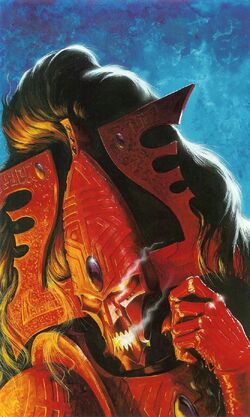
An Avatar of Kaela Mensha Khaine, the Bloody-Handed God.
Kaela Mensha Khaine is one of the only two surviving gods of the Aeldari before the recent awakening of Ynnead. In the old Aeldari pantheon, he was second only to Asuryan himself in power, and was often shown as the enemy of Vaul, the smith god. He is also the most violent and reckless of the gods.
Asuryan was so appalled by Khaine's murder of Eldanesh, a mortal Aeldari, that he cursed Khaine and made his hands drip eternally with the blood of Eldanesh so that all would remember what he had done. The Aeldari say that when Slaanesh awoke, it (Slaanesh can appear as either gender at will) consumed each of the other Aeldari gods in the Warp in turn.
While his counterparts were all devoured, Khaine took up his great sword and did battle with Slaanesh in the Immaterium instead. Khaine was not strong enough to destroy Slaanesh, but he was too powerful to be defeated. Instead his psychic signature in the Warp was broken, and scattered into pieces.
These divine fragments were driven from the Warp where they had done battle and came to rest in the heart of the Infinity Circuit of each craftworld. These pieces of the god became the Avatars of Kaela Mensha Khaine that serve as the most potent unit to provide support to the Asuryani militaries of the craftworlds.
In times of war the Asuryani can awaken the Avatars to lead them into battle, though the price is the sacrifice of an Exarch's life, for the Avatar needs to possess a physical body to enter the material universe.
The Avatars of Khaine are towering monsters with skin of iron and molten cores, hands permanently dripping with blood as Khaine's did in the mythic cycles.
Cegorach, God of Tricksters and Artists

Cegorach, the Laughing God
The only other known surviving god of the ancient Aeldari pantheon, Cegorach, also known as the Laughing God, the Great Harlequin, the Great Fool and the First Fool, was a consummate trickster and the greatest artist among the Aeldari gods.
While most of the Aeldari gods were destroyed by Slaanesh during the Fall of the Aeldari, according to legend this deity survived because his mocking and less self-interested nature distanced him from the collective psychic corruption and decadence of the ancient Aeldari Empire that birthed the Dark Prince.
Other legends tell that when all the other gods were destroyed, Cegorach fled before Slaanesh until Khaine rose to do battle with She Who Thirsts. It is said that during the fight between Slaanesh and Khaine the Laughing God hid behind Khaine for protection, and in the aftermath of the struggle Cegorach fled into the Webway where Slaanesh could not find him.
He still resides there, and is the only being in the universe who knows exactly where every door in the Webway leads. As the master and patron god of the mysterious Harlequins, Cegorach is the only Aeldari god that still remains in his original form.
The Harlequins are protected from the soul thirst of Slaanesh in a different way from their craftworld brethren. While the Asuryani wear Spirit Stones which absorb their souls when they die to prevent them from being devoured by Slaanesh in the Warp, the Harlequins are directly protected by their faith in their god's power, becoming one with his Warp emanation upon their death.
The only exception to this are the Harlequin Solitaires whose souls must be won from Slaanesh after their deaths by the Laughing God.
Asuryan, King of the Gods
Sometimes known as the Phoenix King, Asuryan was the king of the pantheon of Aeldari gods.
While the mythic cycles seem to indicate that he held sway over all the others, he was nevertheless consumed by Slaanesh in the Warp. He is often depicted in relation to fire and light, his chief symbols.
The Asuryani believe that it is Asuryan who taught them how to use the Asuryani Path to prevent their darker natures from overwhelming them and is the reason they named themselves the Asuryani, the "Children of Asuryan."
Isha, Goddess of the Harvest
The Great Mother of the Aeldari race, Isha is a fertility goddess in many respects. She was imprisoned by Khaine for a period of time, until Vaul paid her ransom.
She is often depicted crying, and her symbol is a teared eye, symbolic of her sorrow in being separated from her mortal children. Her tears are said to have solidified to form the Spirit Stones which keep the Asuryani safe from Slaanesh after their death.
It is rumoured among the Asuryani that Isha has not been consumed by Slaanesh like most of the other Aeldari gods, for the Chaos God Nurgle, the Plague Lord, coveted the Aeldari fertility goddess, and rescued her from consumption by Slaanesh only to imprison her in his decaying mansion that lies within his foul realm in the Warp.
These stories claim that Nurgle "cares" for Isha by keeping her within a cage and feeding her the various diseases he concocts, only for her to whisper the cures for each one to mortals in realspace when his back is turned.
Vaul, God of the Forges
The artificer and smith of the Aeldari gods, Vaul is one of the central deities of the Aeldari pantheon, and an eternal enemy to Khaine.
In order to purchase the freedom of his fellow gods Kurnous and Isha after they had been imprisoned by the war god for violating Asuryan's law against the gods remaining separate from their mortal children, Khaine demanded one hundred blades from the Smith God as payment for their freedom.
Vaul was unable to finish the last divinely-crafted blade in time, and so hid a mortal-forged blade amid the others of divine craftsmanship. This fooled Khaine long enough to get Isha and Kurnous to freedom, but when the Blood-Handed God realised he had been tricked, he cried out for vengeance.
Vaul finished the final divine blade, Anaris the Dawnlight, and took it to do battle with Khaine. Though it was the greatest of all swords, Khaine was the better warrior and crippled Vaul. The Smith God is often shown chained to his anvil, the punishment that Khaine set upon him for his deception.
Morai-Heg, Goddess of Fate
The Crone Goddess Morai-Heg is also the consort of Khaine and the third in a trinity of female Aeldari goddesses including Lileath and Isha, who together represent Maiden, Mother and Crone. Morai-Heg appears as an ancient and withered creature who holds the fate of mortals inside a rune pouch made of Aeldari skin.
In Aeldari myth she sought to partake of the eternal wisdom contained in her divine blood. She manipulated her husband, the war god Khaela Mensha Khaine, to cut off her hand so that she might drink deep of her own vitae.
With this deed Morai-Heg gained the knowledge that she sought, and in return, Khaine gained the aspect of the banshee. Her severed fingers each became one of the Aeldari artefacts known as the Croneswords now sought by the Ynnari to fully awaken Ynnead, the god of the dead.
The original homeworlds of the Aeldari that were lost to the Eye of Terror after the Fall of the Aeldari became known as Crone Worlds, a reference to the Crone Goddess.
The inhabitants of Craftworld Iybraesil are noted for being devoted followers of Morai-Heg.
Ynnead, God of the Dead
Ynnead, the Whispering God, is a dream, the embodiment of a possibility that has yet to be fully realized. Some Asuryani Seers long believed that when the last Asuryani dies during the Rhana Dandra (the Final Battle with Chaos), Ynnead will be born from the Warp with the strength of all the Asuryani souls stored in the Infinity Circuits of the craftworlds and the World Spirits of the Exodites.
Ynnead will then have the power to destroy Slaanesh forever in a final battle, thus correcting the mistakes which led to the Fall of the Aeldari and allowing the race to be reincarnated into a universe free of the taint of Chaos.
Or at least that is what the Asuryani believed would happen for almost ten thousand standard years. Then, in 999.M41, during the Battle of Port Demesnus on the moon of Coheria, the High Farseer Eldrad Ulthran partially completed a ritual intended to awaken Ynnead using the power of the souls found in the Infinity Circuits of every craftworld in the galaxy.
While the intervention of the Imperial Deathwatch interrupted the ritual before it could be completed, the god of the dead was partially awakened, and sought out a champion and prophet to complete his rise in the form of Yvraine, the Daughter of Shades. Yvraine founded a new Aeldari faction dedicated to the Whispering God's resurrection known as the Ynnari.
The Ynnari, with members drawn from the Craftworld Aeldari, the Harlequins, the Asuryani Outcasts and the Drukhari of Commorragh, seek the restoration of the ancient Aeldari race by collecting the artefacts known as the Croneswords from across the galaxy.
Their combined ritualistic use at a single focused point in realspace will allow Ynnead to fully manifest his power in the Warp, where he will combat Slaanesh, hopefully destroying the Prince of Chaos and freeing the Aeldari from the soul-devouring curse of She Who Thirsts forever.
Only then will the Eldar people, restored to the unity of the ancient Aeldari, seek to rebuild a new and better interstellar empire.
Other Gods
- Kurnous, God of the Hunt - Kurnous was the father of the Aeldari race and the companion and consort of Isha. He is often shown in conjunction with hounds, hawks, and other trappings of the hunt. Along with his wife Isha, the goddess of the harvest, he too was imprisoned by Khaine for violating Asuryan's edict against communion between the gods and mortals, an act which helped to unleash the mythical War in Heaven and the battle between Khaine and the smith god Vaul.
- Gea - Gea was a minor goddess who existed within the ancient Aeldari pantheon. She is notable for being the consort of the twin deities Khaine the Bloody Handed God and Asuryan the Phoenix King.
- Hoec - Revered amongst the near-invisible assassins known as Pathfinders, the mysterious wandering Aeldari divinity named Hoec is said to be one with the Webway, and has walked the paths between planets since the stars themselves were young.
- Lileath, Goddess of Dreams (also known as Lilcarth) - Lileath the Maiden was the goddess of dreams and fortune in the Aeldari pantheon.
- The Cosmic Serpent - In Aeldari myth, the Serpent is the only creature believed to exist in both the material and the psychic universes at the same time. Hence, the Serpent is said to know all secrets past and present. Saim-Hann means "Quest for Enlightenment," for the Aeldari Lexicon word for snake and secret knowledge is identical: "Saim." The Asuryani of Craftworld Saim-Hann bear the world-rune that represents the Serpent as their heraldry, emblazoning it on the cowlings of their jetbikes, grav-tanks and air support.
- Cobra-God - The Cobra-God is an animistic creature of destruction who does not care who is caught in his wake; he is venerated by the Exodites.
- Scorpion-God - The Scorpion-God is an animistic spirit of defence, brother of Cobra; he is also an animistic spirit deity venerated by the Exodites.
- Serpent-God - The Serpent-God is an animistic creature of secrets and wisdom who knows all there is to know in the universe; he is the third major spirit deity venerated by the Exodites.
Relations With Other Races
As with most of the primary factions in the 41st Millennium, the Eldar have no particular love for any of the other major intelligent races in the universe. Though they abhor the Forces of Chaos more than any other since they have lost more than most civilisations to the predations of the Ruinous Powers, they do not particularly desire to share their knowledge or co-exist with their fellow space-faring species. They have been known to trade and have relations with the other Elder Races.
Mankind
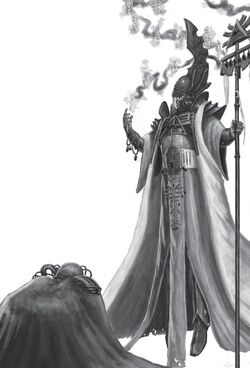
An Eldar Farseer interacts with an Imperial agent
Relations between Mankind and the Eldar were not always sour, but perhaps the current state of warfare between the Eldar and the species they derogatorily refer to as the mon-keigh (literally "mammals" in the Eldar Lexicon, though with a derogatory meaning closer to "monkeys" in Low Gothic) could be blamed on the events preceding the Horus Heresy -- most notably, the meeting between Fulgrim, Primarch of the Emperor's Children Legion of Space Marines and the Eldar Farseer Eldrad Ulthran upon the Eldar Maiden World of Tarsus during the Great Crusade. Both leaders had come in peace to discuss the Imperial Compliance of the planet and Fulgrim's willingness to ignore Imperial doctrine on the matter and leave the Eldar's Maiden Worlds unconquered by the Imperium, but the main issue that Eldrad was attempting to pursue was that the Imperial Warmaster Horus had turned to Chaos, and sought to betray the Emperor of Mankind. However, Eldrad was unaware that Fulgrim had already been tainted by contact with the Slaaneshi daemonblade that he had recovered from the world of Laeran, and the supposedly peaceful meeting soon turned into a bloody battle when Ulthran sensed that the Emperor's Children had already been corrupted by She Who Thirsts. Being that Fulgrim was unaware of the existence of a Chaotic taint on himself and his Astartes, or even what Chaos was at the time of their meeting with the aliens, the Ulthwe Eldar's actions were seen as a betrayal and great insult to the offer of friendship and peace that Fulgrim had offered them with the Imperium of Man. Hence, Mankind and the Eldar have been at nearly open war since the days of the Horus Heresy.
Though they have had no love for the Imperium of Man, which they view as a brutish, repressive and extraordinarily arrogant government (though in truth no more arrogant than the Eldar themselves were before the Fall) the Eldar typically leave human settlements alone and have fought side-by-side with the Imperial Space Marines and troops of the Imperial Guard on multiple occasions, though they have been known to attack unprovoked for reasons of their own and have used other races as shields against certain threats such as the Orks. In campaigns like the Gothic War and the 13th Black Crusade, both races have been seen working together against their common foe of Chaos. In truth, though neither species will ever truly understand the other, and there are a great many differences between them, they both need the other to survive the terrible threats that face both races and they are both far more alike in their mutual arrogance and disdain for other species than either would be comfortable admitting.
Orks
As the most primitive intelligent starfaring race in the galaxy, the Eldar look down upon the Orks and all of their actions. Essentially a green wrecking ball hurling through space, the Orks destroy and loot every world in their path. This has put them at odds with the Eldar many times. However, due to their limited intelligence, the Orks have often made excellent pawns in Eldar schemes designed to save Eldar lives from another, even more potent threat from the Imperium or the Tyranids.
Chaos
As the first race most predominantly affected by Chaos, the Eldar have devoted all of their resources to battling the forces of Chaos whenever possible. This has made them temporary allies of the Imperium on occasion though such partnerships rarely last beyond the span of a few battles.
Tyranids
The Tyranids are a seemingly unstoppable force in the universe, the origins of which are still unknown. The Eldar have dedicated much of their time and sacrificed many in the fight to stem the spread of the Tyranid Hive Fleets. Though only three major Tyranid incursions have actually occurred, the universe is forever under threat from further Hive Fleet invasions. Billions on all sides were sacrificed in the fight to stem the Tyranid flow, but the Eldar are not above sacrificing entire human worlds in favor of diverting the swarm away from their own Craftworlds.
Perhaps the most notable conflict between the Eldar and the Tyranids was the bloody battle between the Craftworld Iyanden and Hive Fleet Kraken, which reduced the massive Eldar cityship to mere remnants of its glory, and which was saved only through the timely intervention of the Pirate Prince Yriel and his Eldritch Raiders.
Necrons
The Eldar have much experience with these dark, evil beings since they were originally created by the Old Ones to aid them in their ancient war with the Necrons. The Eldar have been searching for ways to rid the universe of the foul Necrons for thousands of years. As a relatively recent addition to Warhammer 40,000 lore, the Necrons are a threat to all life in the universe, putting the Eldar in alliance with the Imperium once more against this foe. As usual, such alliances are fleeting and do not last beyond major battles against the Necrons.
Tau Empire
"I have followed the myriad potential futures of the Tau with great interest. Though barely even striplings compared to us, I feel a strange protectiveness towards them. In time I believe they will exceed even our greatest feats and master the darkness within their souls."
- — Farseer Eldrad Ulthran of Ulthwé
So far, there have been no reports of any major contact between the Eldar Craftworlds and the Tau Empire. However it can be assumed that one of three things would happen should the Eldar and the Tau have more contact: The Tau see the Eldar as a threat to their Empire and the Greater Good, the Eldar Craftworlds come to view Tau expansionism as a threat to their way of life, or the Tau offer the Eldar a place in their Empire, which the Craftworlds would view with outright scorn. As the Eldar ultimately want to re-establish their own interstellar empire, they have no desire to bow to the effectively newborn interstellar civilisation of the Tau. As such, the Tau's hopes for the Eldar would be ill-founded. Finally, the Eldar and the Tau may come into conflict because the Eldar don't believe in the Tau's overriding philosophy of the Greater Good. The Eldar were sailing the stars long before Mankind, never mind the Tau, and have actually physically interacted with their own Gods in the past. The Tau Empire's philosophical belief of the Greater Good would seemingly have little appeal to the far older, more cynical Eldar, most of whom would likely consider Tau ideology to be grossly naive.
Forces of the Eldar
Commanders
Avatar of Khaine
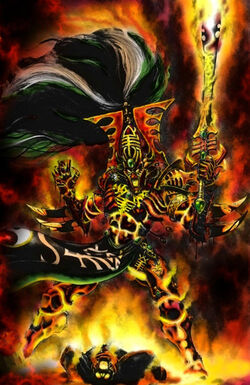
An Eldar Avatar of Khaine stands victorious over a fallen Space Marine
An Avatar of Khaine is the term normally applied to the physical form that the spirit of an Eldar God has managed to possess and animate. This term is most often applied to the physical body possessed by a fragment of the spirit of the Eldar God of War Kaela Mensha Khaine, though the term can actually apply to any divine entity of the Warp that has found some way to take on a corporeal form within realspace. During the Fall of the Eldar, Khaine fought with the newborn Chaos God Slaanesh shortly after "She Who Thirsts" birth, following the destruction of the other Eldar Gods by the newly emergent Prince of Chaos. During the battle, Khaine's essence was shattered and scattered across the universe, ultimately coming to reside in the psychically-reactive Wraithbone hearts of the remaining Eldar Craftworlds. Wherever his essence landed, a wraith artefact was created, allowing future Eldar to be able to summon the spirit of Khaine back into the Materium to defend his race when a Craftworld faces a particularly dire crisis. The Avatar of Khaine is an ancient god incarnate, and his massive form is fearsome to behold. His eyes glow red as bubbles of fiery ichor burst and solidify upon his incandescent skin. Tendrils of acrid smoke and flying cinders enwreathe him like a dark crown, and thick red gore drips from the fingers of his left hand. Clasped in his right hand is the Wailing Doom, the sacred weapon of the Bloody-Handed God. Summoned to war through arcane rituals, the Avatar marches at the forefront of his army, and the Eldar who march in his wake are galvanised by his sheer bloodlust. Their fear and hesitation is burned away in an instant, replaced by an unholy joy in the anticipation of battle, and a murder-thirst that must be slaked. In those precious moments, the Eldar reach the pinnacle of greatness, transformed from survivors to conquerors once more. A cry of pure exultation echoes across the battlefield. It is then that the killing begins.
Autarch
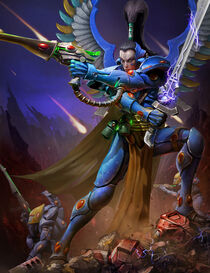
An Eldar Autarch in battle
An Autarch is one of those few members of the Eldar species who have mastered many of the Eldar Paths over the centuries, including one or more facets of the Path of the Warrior. They possess a consummate understanding of the art of war and serve as the supreme commanders of an Eldar Craftworld's warhost. This Eldar Path, known as the Path of Command, is pursued by highly skilled individuals who believe martial excellence can be achieved by gaining a wider perspective of battle that allows the Eldar warhost to achieve victory in the most efficient and lethal way possible. When an Eldar leaves an Aspect shrine, he abandons its teachings and disciplines, forsakes its weapons and wargear, and absolutely disassociates himself from it in the pursuit of a completely new Path. Not so the Autarch, whose duty it is to learn about each Aspect in turn so that he might better guide them in defence of the craftworld. To this end, the Autarch will join each of his Craftworld's most prevalent shrines for a time, learning all that he can of the rituals, skills and battle doctrines of that Aspect. Once he has taken the teachings of that shrine into himself, he will leave, though he will first participate in a ceremony with the shrine's Exarch known as the Rhaan Lona, or the Covenant of Wargift. In this secretive rite, a selection of weapons, armour and wargear of the shrine are laid out before the Autarch, from which he chooses a single item to take with him on his ritual journey. The Autarch retains this wargear throughout his life, using it -- and the knowledge that it represents -- for the betterment of his craftworld. The Autarch possesses an unparalleled strategic ability which far outshines an Exarch's obsession with only a singular facet of war. This enables an Autarch to lead a warhost that operates in perfect unison, with each component of the Eldar war machine functioning in perfect synchronicity. It is not only at the aspect of command that an Autarch excels, for they are consummate warriors as well, and often spearhead assaults, fighting an enemy army's leader in personal combat or contemptuously destroying war machines with ease. Autarchs are considered integral parts of Eldar culture due to their versatility and ability to lead the Eldar on the myriad paths of life and death.
Farseer
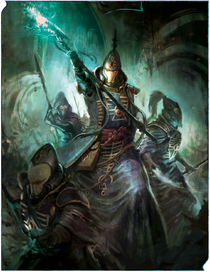
An Eldar Farseer and fellow Seers of Craftworld Ulthwé in battle
A Farseer is the most potent and respected form of Eldar psyker or Seer. The Path of the Seer is the most dangerous and convoluted journey of all, for all psykers are intimately connected to that heinous mirror of reality, the Warp. To proceed along the Witch Path without caution would be to invite damnation, for the minions of the Great Enemy lurk within the Warp ready to rend the souls of overambitious Seers. Even when used wisely, the Path itself can claim an adherent for the rest of his life. Just as Eldar who are trapped on the Warrior Path become Exarchs, so Seers who progress too far along their own Path become Farseers. Masters of prediction, the Farseers are the strangest and most visionary of a Craftworld's advisors. Even in battle they can perform their divinations, casting the complex wraithbone runes of the Eldar into the air and interpreting changes as the glowing icons orbit around them. In this way, the Farseers explore the myriad skeins of present and future, studying the consequences of the smallest decision, the better to guide their people to victory. A council of the most powerful Farseers generally governs a Craftworld. Farseers possess a wide diversity of psychic specialities with divination being the most common skill. They are most often known for using their vast psychic powers to see the possibilities of the future to be able to manipulate events to better ensure the survival of the Eldar species in the wake of the Fall. Unsurprisingly, the primary role of the Farseers is to look into the future and try and discern the best path for the Eldar to take. This is done through the casting of Seer Stones, fragments of Wraithbone and other psycho-sensitive materials that react to the convoluted, probabilistic skeins of space-time. By reading the throw of these stones, the Seers can often determine what will be the most beneficial course of action, though it is rare that they can discern true results any great distance into the future. On occasion a powerful Seer will receive a portent of some calamitous event, and be able to steer the Eldar away from disaster and doom.
Warlock
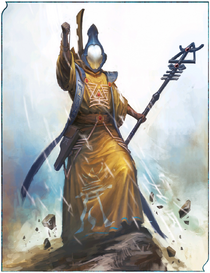
An Eldar Warlock of Craftworld Iyanden
A Warlock is an Eldar Seer or psyker who previously walked the Path of the Warrior as an Aspect Warrior of the Eldar Craftworlds and now uses his potent psychic powers to help lead Eldar warhosts. Perahps because of some hidden mark that Khaine has left on their soul, those Seers who have trained as Aspect Warriors find it easier to develop destructive psychic powers. These individuals become their warrior-seer selves by returning to their old shrines. If his blood sings with the need to fight, a Warlock accepts his mask, and recreates the two-fold division of the mind into self and warrior. Warlocks who lose themselves upon this Path ultimately become Farseers. The most aggressive and warlike of all the potential variants of the Path of the Seer is that of the Warlock. Since Warlocks are Seers who once trod the Path of the Warrior, their previous experience as Aspect Warriors allows them to harness their more destructive impulses when using their psychic powers in combat. In battle, Warlocks often lead from the front, splitting off from their Seer Councils and casting the runes of battle to bolster the warhost and to bring havoc to their enemies. Few can match the arcane might of an Eldar Warlock in the midst of a battle trance, his destructive aura crackling outward to destroy those foes beyond his reach. The ornate helmets worn by Warlocks in the field are kept in the shrines of the Warrior Aspects as a sign of the close link between Warlocks and their former status as Warriors. A Warlock can only attain that status by returning to the Aspect Shrine that he once belonged to and receiving his helmet from the shrine's Exarch as part of the same blood-ritual undergone by Aspect Warriors.
Phoenix Lord
A Phoenix Lord is one of the greatest warriors of the Eldar and the leaders of their particular group of Aspect Warriors. Each Phoenix Lord founded one of the Aspect Shrines of the Eldar, and is the embodiment of that aspect of the Eldar War God Khaine. They have transcended the bounds of normal mortality, in a fashion. The spirit of the original Phoenix Lords was infused into a Spirit Stone within their armour, and merges with the current personality of the wearer of that armour, who is always chosen from among the mightiest of the Exarchs of that particular Aspect Shrine. When the Phoenix Lord falls in combat, another Exarch will don the armour and assume the memories and abilities of the Phoenix Lord. However, many believe that the Phoenix Lords are animated suits of armour possessed by the spirits of the dead Exarchs of that Aspect. This theory, however, is contradicted by the existence of Soul Stone technology, which all Eldar make use of to protect their souls from being consumed by Slaanesh within the Warp when they die.
- Asurmen - Asurmen, whose name means the Hand of Asuryan, is the first and oldest of the legendary Eldar Phoenix Lord, those most ancient of Exarchs from whom the Aspect Warriors themselves were created and who are the absolute masters of their Aspect's form of combat. Each is a demigod of battle whose legend spans the stars, imbued with supernatural powers that grant them the ability to cheat death. Asurmen himself is the living embodiment of the warrior, just as the Avatar is the incarnation of the Bloody-handed God himself. Asurmen acts as Asuryan's immortal scion since that Eldar God was devoured by Slaanesh during the Fall. Asurmen led his people into exile, abandoning his homeworld in the Eldar empire to the horrors of the Eye of Terror's birth. It was Asurmen who founded the first of the Aspect Shrines, the Shrine of Asur, the forerunner of the Dire Avengers Aspect. Asurmen is the forefather of the Dire Avengers, most noble and vengeful of all the Aspects. Today, this Warrior Aspect is the most common amongst the Eldar, and their shrines are the largest amongst all the Craftworlds.
- Karandras - Karandras, "the Shadow Hunter," is the Eldar Phoenix Lord of the Striking Scorpions Aspect Warriors. Legends of Karandras the Shadow Hunter tell of one of the most mysterious of all the Phoenix Lords. Unlike his fellow Phoenix Lords, Karandras was not the first of the Exarchs of the Striking Scorpions. It is said that this singular honour belongs to the one that came before him, Arhra, the Father of Scorpions, the most sinister of all the Phoenix Lords. Arhra was lured to darkness and betrayed Asurmen and the other Asurya, the first Phoenix Lords, by bringing daemons into the First Shrine to wage war upon his fellows. Those loyal to Asurmen were defeated and scattered across the stars, but Arhra himself would eventually flee into the Webway, becoming "the Fallen Phoenix who burns with the dark light of Chaos."
- Jain Zar - Jain Zar, "The Storm of Silence," is the Phoenix Lord and founder of the Eldar's Howling Banshees Aspect Warriors. Jain Zar was the first warrior chosen to serve at the side of the first Phoenix Lord, Asurmen, and the first of her race to become an Exarch, those Eldar who can never leave the path of the Warrior for they can never take off the war mask of Khaine.
- Fuegan - Fuegan, "the Burning Lance," is the Phoenix Lord of the Fire Dragons Aspect Warriors, who schooled the first of them in the art of war with fire and flame. He learned the arts of war in the Shrine of Asur, under the eyes of Asurmen in the distant time many millennia ago when the first Aspect Warriors of the Eldar were trained. Fuegan was thought lost when the Shrine of Asur was destroyed by Arhra, the Fallen Phoenix. Fuegan disappeared for many centuries, before reappearing during the final battle at Haranshemash, "The World of Blood and Tears" in the Eldar Lexicon, to fight alongside the Eldar. The eventual fate of Fuegan is foretold in the last stanza of the Asuryata, the legend of the Phoenix Lords, known in full only to the Bards of Twilight. This passage says that it will be Fuegan who calls all of the Eldar Phoenix Lords for the Last Battle, the Rhana Dandra, and the Burning Lance will be the last of his brethren to die in that conflict, when the footsteps of Daemon kings and demigods shake the earth, resulting in the final death of the Eldar race, and their Gods alike as the price for the elimination of Chaos within the Immaterium.
- Baharroth - Baharroth, "the Cry of the Wind," is the Winged Phoenix, the oldest of the Swooping Hawks and the first Exarch of those winged Aspect Warriors. Baharroth is the founder of the Eldar Warrior Path that is represented today by the Swooping Hawks Aspect Shrines. Baharroth is also known for his speed and is said to be the fastest of all the Eldar who have ever lived, a formidable claim that would make him a deadly opponent indeed. Though he moves with the subtlety and grace of a zephyr, he attacks with the force of a hurricane.
- Maugan Ra - Maugan Ra, "the Harvester of Souls," is the founder and Phoenix Lord of the Eldar's Dark Reaper Aspect Warriors. He was the lone survivor of the once-lost Craftworld of Altansar, which was swallowed by the Eye of Terror five hundred Terran years after the Fall. During the 13th Black Crusade, Maugan Ra led a daring raid into the Eye and rescued the remnants of his long-lost home Craftworld, guiding them out of the Eye of Terror and denying Abaddon the Despoiler his ultimate victory over the Imperium of Man.
- Irillyth - Irillyth, "the Shade of Twilight," is the Eldar Phoenix Lord of the long-extinct Shadow Spectres Aspect Warriors. Lost for millennia, the Shadow Spectres were long forgotten and Irillyth's Aspect Shrines were abandoned. During the Betalis III Campaign in 894.M41, the Shadow Spectres of the Mymeara Craftworld returned from the mists of legend and managed to recover the armour of Irillyth, giving the Eldar new hope that other portions of their lost patrimony and culture might one day be recovered.
Elites
Striking Scorpions
Striking Scorpions are Eldar Aspect Warriors who epitomise the deadly attributes of their namesake, and they are the most skilled of all the close-assault Warrior Aspects on the Eldar Path of the Warrior. They are merciless killers without exception, reveling in the hunt and the kill, using stealth and shadow to cloak themselves from sight until the moment of attack. The Striking Scorpions represent the wrath of the War God Kaela Mensha Khaine, which can fall without warning and with extraordinary savagery upon his foes. The Striking Scorpions are one of the Eldar Warrior Aspects dedicated to close combat, particularly close combat during infiltration missions in which they must first close with the enemy undetected before unleashing their wrath. Many Striking Scorpions are physically more powerful than standard Eldar, and can match their Dark Eldar counterparts for sheer physical power. The signature attack of the Striking Scorpion is made by the weapon pods housed on either side of the warrior's helmet, known as Mandiblasters. These are small, short-ranged laser weapons used to deliver a deadly energy sting in close combat that can be psychically triggered.
Fire Dragons
The Fire Dragons are Eldar Aspect Warriors who seek to embody the writhing, sinewy dragons of Eldar Mythology. No Eldar Aspect Warriors revel more in destruction than those who serve the Shrine of the Fire Dragons. Taking as their totem the fierce, fire-breathing creatures of Eldar legend, they epitomise the brutal, wanton destruction of war. When called to arms their goal is the total annihilation of their foes, to the exclusion of all else. Fire Dragons are aggressive and warlike close combat fighters who utilise heat-based weaponry to destroy enemy armoured vehicles and drive the foe from his fortified strongpoints. They have an unsurpassed mastery of their chosen and highly dangerous weapons, and take savage delight in the devastation they create. For this reason, the Eldar believe that the Fire Dragons are the embodiment of the Eldar War God Kaela Mensha Khaine's penchant for pure destruction. It is said that Fire Dragon Exarchs generate a corona of lambent flame around themselves when the battle lust is upon them.
Howling Banshees
The Howling Banshees are the all-female Eldar Aspect Warriors who specialise in highly mobile melee combat and represent the Eldar War God Khaela Mensha Khaine's ability to instill fear in his foes. The banshee is a harbinger of woe and death in Eldar Mythology. Their cry is said to herald ill fate and can even wrench a soul from its Spirit Stone. It is fitting that these most feared of all the Eldar Aspect Warriors draw their inspiration from this creature. These lightly-equipped warrior-women are fearsome melee combat specialists who draw their inspiration from the unearthly creature with which they share a name. What the Howling Banshees lack in brute strength they make up for with their uncanny and inhuman precision and efficiency. The piercing warcry of these Aspect Warriors has heralded the coming doom of countless enemies of the Eldar people.
Harlequin Troupe
A Harlequin, known in the Eldar Lexicon as a Rillietann, is a member of a very distinct sub-group of the Eldar race that belongs to none of the existing Eldar sub-races, including the Craftworld Eldar, the Exodites or the Dark Eldar. They are the keepers of the Black Library and serve the enigmatic Eldar deity called the Laughing God. They are welcomed by all of the other Eldar factions, including the Dark Eldar of Commorragh and the Webway, and are known for their brightly coloured clothing, incredible agility (even for an Eldar), and use of unusually powerful weapons. Harlequins always organise themselves into groups they call Troupes, which are led by a Troupe Master. The Harlequin lifestyle is very like the life of a roaming mime or troubadour of the medieval times. They wander the Webway and occasionally appear at Eldar settlements: on a Craftworld, on Commorragh, an Exodite Maiden World, or even a human world in the Imperium of Man. They perform frenetic, acrobatic dances for the spectators there which are called Masques. Their artistic works portray the Fall, the legendary decline that destroyed the Eldar empire, the birth of the Chaos God Slaanesh, and many other tales from the long history and ancient mythology of the Eldar people.
Troops
Dire Avengers
The Dire Avengers were the first amongst the Aspect Warriors of the Eldar. They represent the Eldar War God Khaela Mensha Khaine in his aspect as the noblest and yet most merciless of warriors. The Dire Avengers show no mercy to their foes and are unwavering in their devotion to their people. These warriors are the least specialised and the most tactically flexible of all the Warrior Aspects, as they serve Eldar armies as elite ranged infantry. The Dire Avengers are also the most common of the Warrior Aspects amongst the Eldar, and their shrines are the largest to be found on all the Craftworlds.
Rangers
Rangers are the scouts of the Eldar Craftworlds, well-trained survivalists and marksmen able to find the eye sockets and neck joints of even the most heavily armoured enemy troops with their Long Rifles. The most skilled of the Eldar Rangers are known as Pathfinders. In order to defeat the constant claim of the Chaos God Slaanesh on their souls, the Craftworld Eldar practice a form of deprivation, narrowing their entire focus onto a single craft, perfecting it and then moving on to another, a system known as the Paths of the Eldar. Many Rangers remain loyal to their Craftworlds and the kin who live upon them even if they do not feel the need to live there, so when the Craftworld goes to war, they almost always provide their aid, offering to conduct reconnaissance of enemy forces and wield their expert marksmanship to harry and cripple enemy forces and eliminate select targets like commanding officers that will cripple the foe's command and control. While some Rangers never return to their Craftworlds, their lives claimed by the alien dangers of some unknown world or consumed by their own passions and ultimate fall into the embrace of Slaanesh, many others do, scarred and finally ready to settle into another Path, their experiences as a Ranger having granted them both a better understanding of themselves and their place in the Eldar society of their Craftworld.
Guardians
Guardians are the militia troops of the Eldar Craftworlds. In times of peace the Guardians pursue their normal civilian roles. All adult Eldar, however, are trained in the arts of warfare and can be called to arms if their Craftworld is threatened. It is a painful irony that, in the Eldar race's endless quest for survival, the very civilians the warhosts fight to protect are all too often forced to take up arms. Every Eldar is trained and ready to fight as a Guardian if need be. In some Craftworlds, Ulthwé foremost amongst them, the Guardians are the most common of all Eldar warriors. As the number of dedicated, professional Eldar troops -- the Aspect Warriors -- in a Craftworld are simply too few to meet all threats, those Eldar dedicated to a civilian path serve as Guardians in battle, forming the bulk of the Eldar armies. Guardians are also called upon to pilot and crew the majority of the Eldar’s many war machines, providing vital armoured support and transportation for the warhost in battle. Guardian forces consist of two main types; the tactically flexible Defenders, and the more assault-oriented Storm Guardians. Both are equipped with Eldar Mesh Armour.
Windrider Jetbike Squad
Those Guardians who pilot Eldar jetbikes into battle are known as Windriders. So carefully wrought are the incredible machines they ride that a skilled pilot can cross leagues in the space of a few heartbeats before shredding his awed foes with the paired shuriken catapults that allow the jetbike its famously deadly rate of fire. The Windriders are rightfully proud of their mastery of flight. Upon the cowling of each jetbike, the heraldry of the craftworld and sometimes the specific Windrider squadron are emblazoned in pride of place. These colours are invariably bold and defiant, for the Windriders have no fear of the foe, for their steeds mock gravity itself.
Fast Attack
Shining Spears
The Shining Spears are one of the rarest and most specialised of the Eldar Aspect Warriors. The Shining Spears possess a bright and clear virtue that marks each one out as a warrior hero and a champion of the Eldar race. Eldar mythology is replete with examples of noble heroes at one with their steed and in the Shining Spears, the glories of legend are made manifest once more. In battle, they fight as the Spear of Kaela Mensha Khaine, the invincible weapon of the Eldar God of War that struck like lightning and killed any foe with a single blow. Shining Spears can be distinguished from all of the other Eldar Warrior Aspects for they are the only Aspect Warriors to make use of anti-gravity Jetbikes. The identity of the Shining Spears Aspect's Phoenix Lord Drastanta is not known to Imperial scholars.
Swooping Hawks
The Swooping Hawks are the aerial Aspect Warriors of the Eldar. They wear cunningly constructed anti-gravitic wings that enable them to launch high into the air at a moment's notice. They are able to launch lightning-fast aerial assaults against their foes, cutting them down with the deadly energy weapons known as Lasblasters in a blur of colour. The Swooping Hawks take their name from the wild hunting birds of Eldar Mythology, who symbolise revenge and retribution. Just as these birds of legend contained the spirit of a murdered Eldar, hovering over their killers as a mark of guilt, so too do the Swooping Hawks fly across the battlefield, dealing swift death as retribution to the enemies of the Eldar.
Warp Spiders
The Warp Spiders are Eldar Aspect Warriors who specialise in the use of a personal teleportation device built into their Aspect Armour to make a series of rapid jumps through the Immaterium that make them nearly impossible to target and allow them to attack the enemy suddenly and disappear before he can strike back. Taking their name from the same creatures who protect the Infinity Circuits of their Craftworlds, the Warp Spiders epitomise the concept of an aggressive defence.
Crimson Hunters
The Crimson Hunters are amongst the most unusual of the Eldar Aspect Warriors. Their ritual wargear is not blade or sidearm, but instead a sleek aerial fighter that represents the pinnacle of Eldar aeronautics. These formidable aircraft, known as Nightshade Interceptors, are just as much a part of the Crimson Hunter's battlegear as the Howling Banshees' Power Sword or the Dire Avengers' Shuriken Catapult. Their lethality, however, is measured on a different scale altogether. The Crimson Hunters are few in number, though their Aspect Shrines are becoming ever more widespread amongst the Eldar Craftworlds. These temples to Khaela Mensha Khaine, the Eldar God of War, are unlike any other. They are not buildings or landscapes at all but tunnel-linked collections of transparent atriums that float around the periphery of their Craftworlds like archipelagos at the edge of a vast landmass.
Hemlock Wraithfighters
The Hemlock Wraithfighter is a weapon of utmost terror and is the subject of much controversy among the Craftworlds. To use such a device is to teeter on the brink of atrocity. Only the most dire circumstances could force the Eldar to employ such an abhorrent device, and those who do so have a stain upon their soul that is not easily erased. Yet the Autarchs know that they have little option -- they must use every weapon in their quest for survival. The Hemlock blends the psychic abilities of is Spiritseer pilot with the sinister gestalt energies of the Eldar dead, their co-pilots -- Spirit Stones -- whose psychically reactive wraithbone core functions like a miniature infinity circuit. Each Spiritseer pilot risks being driven slowly insane by the whispering voices within his Hemlock, or, after communing with his co-pilots one too many times, having his spirit forever join the ghosts within the craft and leaving behind nothing more than an empty husk.
Vyper Squadrons
Vyper Squadrons fly the sleek skimmer known as the Vyper Jetbike, fighting in the midst of the Eldar's fearsome Windrider hosts, offering a perfect compromise between the speed of a jetbike and the heavier armament of a grav-tank. A military innovation initially pioneered by the artisans of Saim-Hann, Vypers are two-seater attack craft capable of mounting a variety of heavy weapons. Their relatively small size means that they can travel through all but the thinnest arterials of the Webway, and their prodigious armament enables them to rival many tanks in terms of firepower. Their sheer speed provides more surety against incoming fire than any amound of armour plating -- it is rare for a Vyper squadron to move at anything less than breakneck pace while a battle rages.
Heavy Support
Heavy Support Troops
Dark Reaper
The Dark Reapers are the most menacing of the Eldar Aspect Warriors. They exemplify the Eldar War God Kaela Mensha Khaine in his aspect as the Destroyer, and their skull-masked costume echoes that of their founder and Phoenix Lord, the "Harvester of Souls," Maugan Ra. Although the Dark Reapers are comparatively slow-moving compared to other Eldar warriors as a result of their heavy armour, this is of little consequence, for their role on the battlefield is to serve as long-ranged heavy weapons fire support for the more mobile Eldar units. They are perhaps the most sinister and lethal of all the Aspect Warriors and their dark armour is adorned with symbols of death and destruction.
Vaul's Wrath Support Batteries
Whilst the artillery of most races can be considered crude and brutal, the Eldar employ support weapon platforms that are as silent as they are lethal. Known to the Eldar as Vaul's Wrath in honour of their smith-god's deadly skills, these large yet graceful war machines are crewed by two experienced Eldar Guardians. Each platform mounts a huge gun with which to slaughter the enemy -- but where the artillery of man or Ork employs blunt explosions and weight of fire, Eldar support weapons utilise a varity of dazzling technology to slay their foes. When Vaul's Wrath support weapons combine their firepower, they hammer the foe just as their namesake hammers the fates of mortal men upon his anvil. The following are the support weapons batteries often employed by the Eldar in battle:
- D-Cannon - An Eldar Distort Cannon, or D-Cannon, uses the Eldar's advanced knowledge of Warp technology to unleash a miniature sphere of Warp energy onto the battlefield, tearing apart its targets. The weapon emits a low droning noise which builds in pitch until it fires with a high-pitched shriek, spewing a beam of impenetrable blackness towards its target -- a momentary rift between Realspace and the Warp. The target is enmeshed in blackness and wrenched momentarily between warp space and reality. The massive internal distortion this causes tears the target apart, and usually destroys it. D-Cannons are often mounted upon anti-grav platforms or Eldar Titans.
- Vibro Cannon - A Vibro Cannon is a uniquely Eldar weapon which uses resonant sonic waves to shake its targets apart and fling troops to the ground. A vehicle hit by a Vibro-Cannon shakes violently and may fall apart, troops are thrown to the ground and quiver uncontrollably, and even the ground itself is ripped asunder by shock waves. The weapon can be directed against a specific point on the battlefield, but is forces are transmitted at ground level, and targets between the weapon and its aiming point can be affected. It is as if a huge plow were cutting a mighty furrow deep into the earth, casting aside rocks and soil, and scattering troops and tanks to either side. A particularly frightening aspect of the Vibro-Cannon is revealed when two weapons cross their line of fire over the same target. When this happens the results are often very spectacular as the ground is torn apart explosively. This particular weapon is often mounted upon an anti-grav platform.
- Shadow Weaver - The Shadow Weaver is a heavy monofilament weapon. It creates a dense monofilament mesh from an organo-polymer compound, which is kept in a liquid state within a magnetic reservoir. This mesh is released through thousands of microscopic firing ducts and woven into a web-like cloud by spinning gravity clamps. When fired, it unleashes a cloud of razor-sharp monofilament wire high into the air, which drifts down onto the enemy, slicing through the flesh and bones of the targets as they struggle to free themselves.
Heavy Weapons
Cobra
The Cobra is an Eldar super-heavy grav-tank that supports Eldar heavy armour assaults. This huge vehicle carries heavy firepower, and is broadly comparable to Imperial Guard super-heavy tanks. The Cobra is an Engine of Vaul, much like it's counterpart, the Scorpion, but re-armed with a large Distortion Cannon (D-Cannon). This weapon is known as a Warp Cannon or Vortex Cannon. There are two versions of the Cobra. Type I has a turret-mounted D-Cannon, while the Type II has a fixed forward firing D-Cannon. The Cobra is designed to find and destroy enemy war machines, as their protective force fields are little defence against the D-Cannon's heinous energies. As with all Eldar vehicles, crew numbers are kept to a minimum. The dwindling civilisation of the Eldar means they must rely upon sophisticated technology and the Wraithbone construction of their vehicles, freeing more warriors from crewman duties to fill the ranks of Guardian and Aspect Warriors squads.
Grav-Tank
Known as "Engines of Vaul", Eldar grav-tanks are immaculate beyond the ken of the lesser races -- aeronautical triumphs that combine ethereal grace with a deceptive lethality. Not for them the ground-churning rumble of Imperial tanks or the oil-drizzling incontinence of the vehicles cobbled together by Ork Mekboyz. Instead, the sleek battle craft of the Eldar guide through the smoke-filled skies, the nimble Falcon as silent as the deadly Fire Prism and the giant Cobra. The only signs of their passage are the blasted bodies left in their wake; regardless of type, they mount weaponry capable of breaking open a battleline.
Falcon
The Falcon is the primary main battle tank of the Eldar. It an anti-gravitic tank that is named for the mythical figure who delivered one of the Swords of Vaul to the hero Eldanesh so he could continue fighting Khaine, the Eldar War God. The Falcon's graceful curved silhouette is a familiar but much dreaded sight to their enemies. The Falcon has a twin role upon the field of battle. It has a passenger compartment enabling it to carry a small squad of infantry to the battle front, or rescue a beleaguered unit when resistance proves too fierce. The Falcon is armed with a Pulse Laser and twin-linked Shuriken Catapults. An additional mount is provided on its turret, capable of accepting almost all heavy weaponry used by the Eldar. It is also fitted with an advanced targeting system to make the best of this armament. However, like most Eldar vehicles, the Falcon has light armor. Its impressive speed compensates for this, as it can cruise at speeds exceeding 800 km/h, and at high altitudes.
Fire Prism
The Fire Prism is an Eldar anti-armour gravity tank based on the design of the Falcon. It replaces the Falcon's infantry-carrying capacity and turret weapons with a massive crystal array, known to Imperial forces as the Prism Cannon. It can fire a dispersed beam that damages targets over a wide area rather than concentrating its fire on a single target but this drastically reduces the weapon's damage. However, two or more Fire Prisms can pool their firepower by combining their Fire Prism beams to geometrically increase their Prism Cannons' firepower. This ability makes Fire Prisms extremely dangerous units when deployed in squadron strength against other armoured vehicles.
Firestorm
The Firestorm is a variant of Eldar Falcon grav-tank. Utilised as the Eldar's standard land-based anti-aircraft defence vehicle, the Firestorm mounts a complex triple-barrelled array of Scatter Lasers in a single-seater turret that fills the sky with streaking laser bolts above an Eldar grav-tank formation. Highly accurate and capable of sustained bursts, the Firestorm is also a potent anti-infantry weapon, particularly effective when used against hordes such as Ork warbands and Tyranid swarms. The Firestorm is also armed with a hull-mounted twin-linked Shuriken Catapults and/or a Shuriken Cannon, and can be further equipped with Vectored Engines, Star Engines, Holo-Fields and Spirit Stones. With a crew of two, the Firestorm retains its troop transport capacity and can assist Eldar attacks by delivering a squad of Aspect Warriors to the battlefield before withdrawing to its usual anti-aircraft role.
Night Spinner
The Night Spinner is an Eldar anti-gravity combat vehicle. It is based on the Eldar Falcon grav tank chassis and is designed to provide indirect mobile fire support to fast-moving Eldar offensives. It is armed with a Shadow Weaver and Shuriken Catapults or a Shuriken Cannon. The Shadow Weaver creates a dense monofilament mesh from an organic polymer compound. The compound is kept in a liquid state within a magnetic reservoir and when released through the thousands of microscopic firing ducts, is woven into a web-like cloud by spinning gravity clamps. The clouds are forces high into the air before they drift down, making them ideal for disrupting an attack and causing the Eldar's enemies to seek shelter. A Night Spinner may also be outfitted with Vectored Engines, Star Engines, Holo-fields and Eldar Spirit Stones.
Scorpion
The Scorpion is an Eldar super-heavy grav-tank utilised exclusively by the Eldar, and is amongst the largest vehicles recorded capable of anti-gravitic movement in the galaxy. Known to the Eldar as one of the Engines of Vaul, it combines sophisticated and powerful weaponry with the grace and speed that have come to be associated with the Eldar's vehicles. Protected by a Holo-Field and armed with twin-linked Pulsars, the Scorpion has earned nicknames like the "Grave-maker" and "Deathsled" from the Imperium's tank crews. The Eldar regard the huge machines of the Imperium or Orks as crude and ungainly when compared with the grace of a Scorpion as it skims into battle.
Walkers
War Walker Squadron
A War Walker is a one person, lightly armoured, bipedal combat walker used by the Eldar. They are manned by a standard Eldar Guardian. The War Walker plays an essential role for Eldar military forces very similar to that of an Imperial Guard Sentinel. Both are nimble, lightly armoured scouting units, though the War Walker is closer in size to the Wraithlord. War Walker pilots often become emotionally attached to their mounts, and a union of the pilot's mind with their machine ensues. This union is aided by the presence of an Eldar Spirit Stone, containing the spirit of a deceased Eldar that has been melded with the walker. The conjoined minds of the pilot and the individual personality within the Spirit Stone provides a much sharper focus and a deadlier concentration in combat that enhances the mission effectiveness of the walker.
Wraithguard
The Eldar Wraithguard are not living warriors; they are artificial robotic constructs created from the complex psycho-plastic material, crafted by the Eldar of the Craftworlds, known as Wraithbone. Each Wraithguard has a Spirit Stone containing the soul of an elite Eldar warrior that was drawn out of the Infinity Circuit of a Craftworld. Wraithguard are smaller in size than Wraithlords, and carry a weapon known as a Wraithcannon which is a short-range, but potent weapon capable of opening a small rift into the Warp which sucks the target, or pieces of the target, within the Immaterium. When used against infantrymen, the result is invariably fatal. Due to their Wraithbone construction, Wraithguards can suffer damage that would cripple, or even kill, a living Eldar warrior and still continue to fight, making them useful in situations that would be suicide for living soldiers. They see through the Warp using what is known as "Wraithsight" but as the Warp is a tumultuous place, Wraithguards often have trouble discerning the true nature of realspace and so can find themselves blinded and unable to function effectively. Because of this tendency Wraithguard are often led into battle by Warlocks who help to guide them.
Wraithblade
The most feared of all the Wraithguard are usually referred to as Wraithblades -- a few Eldar will speak their true name, Klaivaulch, for fear of inciting the wrath of Khaine. Tradition has it that each craftworld keeps these vengeful constructs apart from other ghost warriors so that the immortal anger that pervades their wraithbone shells does not taint those who might one day attain peace. When the call to war is heard, these beings are awakened by the most gifted Seers. Their spirit stones glow hot as the slow-burning anger of the dead flows through their cores. Once kindled, the wrath that animates their wraithbone bodies becomes an unstoppable fury that can only be quenched in the blood of their foe. Wielding twin ghostswords that leave glowing traces in the air, the Wraithblades cut down their foes with both merciless precision and the great might afforded by their long-limbed forearms.
Wraithlord
A Wraithlord is a lithe but mighty noble robotic combat walker that contains no living warrior; rather, it is merely a robotic shell, a repository of the animating soul of a dead Eldar hero. Wraithlords are graceful but mighty giants that dwarf their Wraithguard cousins. These large constructs are extremely precious to their Eldar Craftworlds and have a supernatural toughness due to being made from the psychically-active substance called wraithbone. Summoned into being by the necromantic processes of the Eldar Spiritseers, only a true hero of the Eldar race has psychic power enough to animate the gigantic wraithbone shell of a Wraithlord.
Wraithknight
Looming ghost warriors many times larger than even the might Wraithlords, the war machines known as Wraithknights are still dextrous enough to run through the ruin of a shattered city, leaping from pillar to spar as their arcane weapons bring oblivion to the enemies of the Eldar. Each carries either a pair of heavy Wraithcannons, their lengthy forms capable of sending their targets straight into the hell-dimension of the Warp; a suncannon, powerful enough to obliterate a platoon of human soldiers in a single blast of roiling plasma; or a great ghostglaive and scattershield with which to engage even the Daemon Lords of Chaos in single combat. Their contoured shells house the spirits of the wakeful dead in much the same way as lesser ghost warriors, though their armoured chests each hold a living Eldar pilot within. These pilots are not normal steersmen such as those at the helm of grav-tanks and Eldar aircraft, but rare and unusual warriors who were each born a twin.
Transport
Wave Serpent
The Wave Serpent is an armored personnel carrier based on the same design as the Falcon. It is the standard transport vehicle of the Craftworld Eldar. Armed with twin-linked shuriken catapults and a set of twin-linked heavy weapons, the Wave Serpent is capable of carrying up to twelve Eldar passengers in the expanded passenger compartment. In addition, the prow of the Wave Serpent is protected by an advanced energy shield, reducing the effectiveness of enemy weapons and ordnance.
Craftworld Aeldari Voidships
Craftworld Aeldari voidships, when compared to the massive cruisers and battleships of the Imperium, seem almost fragile. Their voidships lack the thick plating, heavy prows, and bristling towers of Imperial Navy vessels, instead sporting long masts which support the vessel's sail-like solar collectors.
Aeldari starships also have a sleeker shape, generally possessing rounded, almost oval hulls, and an "organic" look, although nowhere near the quasi-insectoid appearance of Tyranid vessels.
Imperial naval officers sighting Aeldari voidships for the first time often dismiss them as easy prey for Imperial Macrocannons and Lances. Nothing, however, could be further from the truth.
The Aeldari are perhaps the most accomplished starfarers in the galaxy. Their ships are significantly more advanced than those of the Imperium, and are equipped with technologies far beyond the abilities of the Adeptus Mechanicus to understand, much less duplicate.
The hull of an Aeldari ship is made not from adamantium plating, but from a material called "wraithbone." Molded by Aeldari craftsmen known as Bonesingers, Wraithbone is literally grown into what ever shape is needed, be it armour, weapons, buildings, or kilometres-long voidships.
Durable, difficult to damage, and even capable to a certain degree of self-repair, wraithbone is psychically active and on Aeldari starships replaces the Vox units and Cogitators found on Imperial vessels.
Wraithbone also manifests innate psychic shielding, partially protecting the vessel (and its crew) against certain manifestations from the Warp.
Instead of crude Plasma Drives, the Aeldari use vast solar sails to collect the light of the stars. These sails allow Aeldari ships to move swiftly and securely, and are one of the reasons behind their impressive and unparalleled manoeuvrability.
Small spacecraft may only have a single solar sail, while larger voidcraft may have two or three, giving the ships the appearance of winged creatures.
Defensively, the Aeldari forego the use of Void Shields and instead rely on their Holo-Fields for protection. A Holo-Field confuses an enemy voidship's targetting sensors by creating multiple "ghost ships" randomly across an area of space.
These sensor ghosts mask the actual location of the Aeldari ship. While this means an Aeldari voidship can be nigh-impossible to hit, their lack of Void Shields renders them vulnerable to those shots that do find their target.
While immensely sophisticated, even Aeldari construction is not as durable as multi-metre thick adamantium armour layers and thousands of redundant components and replacement crew.
Trivia
The Eldar are a race of fey-like humanoids similar in appearance and culture to the sylvan elves of ancient Terran mythology and literature, and they are the most ancient and technologically advanced of all the intelligent races of the Milky Way Galaxy, with the exception of the Old Ones, and their ancient enemies the Necrons. Their armies usually have the advantages of great mobility, potent psychic abilities and technology that is more advanced than that deployed by the human Imperium. In the sense that Warhammer 40,000 races are generally derived from the earlier Warhammer Fantasy universe, the Eldar are derived from the High Elves of the Warhammer World, except for the Eldar faction known as the Exodites who are the equivalent of the Wood Elves.
Etymology and Inspiration
The name Eldar is drawn from J. R. R. Tolkien's work the Silmarillion, where the hunter Valar Oromë discovers Elves far from the Blessed Realm of Valinor, in Middle-earth.
In their own language the Elves were given the name "Eldar" (Quenya for "Star People") by the Valar Oromë, presumably for the fact their birth came in a time before the sun and the moon existed and because the elves have a particular love for the stars. The history of the Eldar in Warhammer 40,000 mimics that of Tolkien's elves, to the point that they are a "dwindling race" in the game universe, as the elves were in Middle-earth's Third Age.
The inspiration for the Eldar is heavily drawn from Celtic culture, such as their largely Gaelic-influenced language (similar to the dominant Sindarin Elvish in Tolkien's works which was somewhat based on Welsh), the names of their craftworlds, their iconography and even one of their units, which is called the Howling Banshees.
The different Eldar Aspect Warrior paths can be seen as reminiscent of the many different styles of Chinese martial arts (kung fu). The Eldar cultural arrogance is similar to the ethnocentrism displayed by the Chinese of the Ming and Qing Dynasties when they first encountered European cultures that they considered barbaric and inferior. The late nineteenth century Chinese Confucian scholar Gu Hongming, speaking to an Englishman, is quoted as saying "Why, when you lived in caves and clothed yourselves with skins, we were cultured people."
The Eldar may also be seen to borrow from Japanese culture to a lesser extent in the appearance of some of their wargear and the use of shuriken-like kinetic ammunition in their most common ranged weapons. The Eldar "Path of the Warrior" can be seen to be akin to the "Way of the Samurai", Bushido.
See Also
- Craftworlds
- Drukhari
- Harlequins
- Asuryani Wargear
- 13th Black Crusade
- Roboute Guilliman
- Terran Crusade
Videos
Sources
- Black Crusade: Core Rulebook (RPG), "The Fall of the Eldar," pg. 322
- Black Crusade: Tome of Excess (RPG), pg. 6
- Citadel Journal 5, "Eldar (Space Hulk 1st Ed.)", pp. 34-47
- Citadel Journal 12, "Eldar Exodites: Rules & Conversions", pp. 26-30
- Citadel Journal 17, "Harlequin", pp. 3-10
- Citadel Journal 18, "Eldar: The Lightning Assault" & "Behind the Masque: (Eldar) Harlequin Tactics", pp. 3-5, 65-67
- Citadel Journal 19, "Harlequin Dreadnought: Eldar", pg. 17
- Citadel Journal 39, "Codex Harlequins: Eldar", pp. 4-13
- Citadel Journal 44, "Codex Harlequins Update: Eldar", pp. 36-39
- Codex: Eldar (3rd Edition), pg. 42
- Codex: Eldar (4th Edition) pp. 14, 16, 20, 50-53, 84-86
- Codex: Eldar Craftworlds (7th Edition) (Digital Edition), pp. 15-16 ("Warhosts"), 33-37 ("The Doom of the Eldar")
- Codex: Craftworlds (8th Edition), pp. 6-29, 110-113, 116 (Quote), 122-123
- Craftworld Iyanden (6th Edition) (Digital Edition), pg. 83
- Dark Heresy: Creatures Anathema (RPG), pp. 76-85
- Deathwatch: The Outer Reach (RPG), pg. 64
- Liber Xenologis: Observations from a Blackstone Fortress (Background Book), pp. 40-43
- Rogue Trader: Battlefleet Koronus (RPG), pp. 84-85
- Imperial Armour Aeronautica, pp. 48-56
- Imperial Armour Apocalypse (2008), pp. 54-64
- Imperial Armour Apocalypse (2013), pp. 93-101
- Imperial Armour Apocalypse II, pp. 54-56
- Imperial Armour Apocalypse Second Edition, pp. 57-68
- Imperial Armour II - Ork, Eldar & Dark Eldar Vehicles for Warhammer 40,000, pp. 10-20
- Imperial Armour Tactica Aeronautica, pg. 36
- Imperial Armour Update 1, pp. 34-37
- Imperial Armour Update 2, pp. 18-27
- Imperial Armour Volume Eleven - The Doom of Mymera
- Planetstrike
- Psychic Awakening: Phoenix Rising (8th Edition), pp. 4-9, 76 (Quote)
- The Art of Warhammer 40,000, pg. 181
- The Gathering Storm - Part Two - Fracture of Biel-Tan (7th Edition), pp. 4-101
- Warhammer 40,000 Compilation (1st Edition), pp. 35-77
- Warhammer 40,000: Rogue Trader (1st Edition)
- Warhammer 40,000: Rulebook (2nd Edition)
- Warhammer 40,000: Rulebook (4th Edition)
- Warhammer 40,000: Rulebook (5th Edition)
- Warhammer 40,000: Rulebook (6th Edition)
- White Dwarf 101 (US), "Chapter Approved: Eldar; The Infinity Circuit, The Spirit-Warriors & Eldar Ghost-Warriors", pp. 52-55
- White Dwarf 105 (US), "Harlequins" by Graeme Davis, pp. 35-46
- White Dwarf 106 (US), "Harlequins Army List" & "Eldar Jet Bike: Stats", pp. 11-18, 40
- White Dwarf 107 (US), "Eldar Harlequin Jet Bike: Stats & Background", pg. 15
- White Dwarf 110 (US), "Eldar - Eldar Phantom Class Titans: Shade & Spectre Variants & Eldar Vehicles", pp. 60-69
- White Dwarf 124 (US), "Eldar: Jes Goodwin's Sketch Book", pp. 30-33
- White Dwarf 126 (US), "Knights: Eldar & Human War Machines", pp. 28-45
- White Dwarf 127 (US), "Eldar" by Rick Priestley, Jes Goodwin, William King & Lindsey D. Le Doux Paton, pp. 13-52
- White Dwarf 136 (US), "'Eavy Metal: Eldar Guardians", pp. 18-21
- White Dwarf 138 (US), "Alaitoc Craftworld Eldar Army", pp. 20-29
- White Dwarf 141 (US), "Alaitoc Craftworld vs. The Blood Angels: Battle Report", pp. 32-45
- White Dwarf 143 (US), "Stompers!" & "(Eldar) Alaitoc Craftworld vs. The Blood Angels: Battle Report", pp. 12-20, 41-59
- White Dwarf 144 (US), "Epic Forces: Eldar" & "Titan Data Sheets: Eldar Titans", pp. 24-33, 62-72
- White Dwarf 147 (US), "Eldar Avatar and War Walker" & "The Eldar Craftworlds Colour Schemes", pp. 9-11, 12-14
- White Dwarf 159 (US), "Eldar in Tyranid Attack" & "Space Marine & Eldar Scouts", pp. 5-12, 14-17
- White Dwarf 160 (UK), "The Assault on Barbarius: Battle Report - Imperial Guard vs. Eldar", pp. 20-39
- White Dwarf 164 (UK), "Doom of the Eldar", pp. 27-32
- White Dwarf 170 (UK), "Epic Eldar Armies", pp. 39-42
- White Dwarf 171 (US), "Warp Spider Aspect Warriors: Eldar", pp. 38-41
- White Dwarf 172 (US), "The Eldar", pp. 5-16
- White Dwarf 173 (US), "Eldar Pheonix Lords", pp. 6-9
- White Dwarf 177 (US), "Hold the Line: Battle Report - Eldar vs. Space Wolves", pp. 52-72
- White Dwarf 186 (UK), "Titan Legions - Eldar Revenant Scout Titans", pp. 37-42
- White Dwarf 189 (US), "The Great Devourer!: Battle Report - Imperial Guard & Eldar Alliance vs. Tyranids", pp. 46-63
- White Dwarf 191 (US), "Tyranid Invasion: GW Campaign of Ichar IV Defense by Ultramarines, Imperial Guard and Eldar", pp. 76-81
- White Dwarf 196 (US), "Civil War: Battle Report - Eldar vs. Eldar", pp. 92-109
- White Dwarf 207 (US), "Aerial Supremacy: The Eldar Vyper Jetbike" & "A Clash of Patrols: Battle Report - Ultramarines vs. Eldar", pp. 10-17
- White Dwarf 304 (US), "Index Xenos: Discussing the Eldar of the Biel-Tan Craftworld", pp. 88-91
- Xenology by Simon Spurrier (Background Book), pp. 25-26
- Warhammer Community - Grim Dark Corners: The Fall of the Aeldari and the Birth of Slaanesh
- Warhammer Community - Psychic Awakening
- Warhammer 40,000 Website (Faction Icons)


